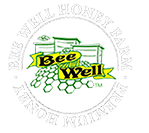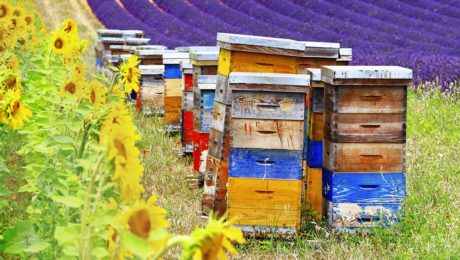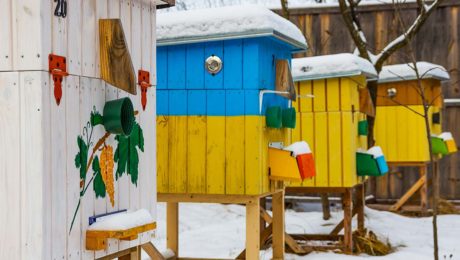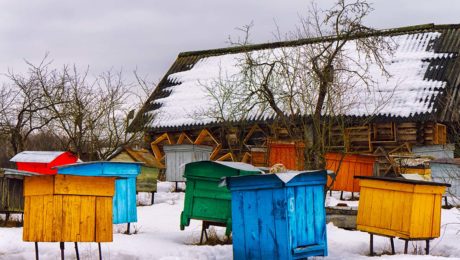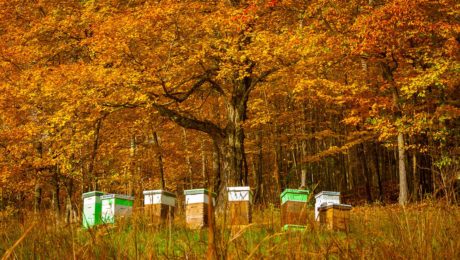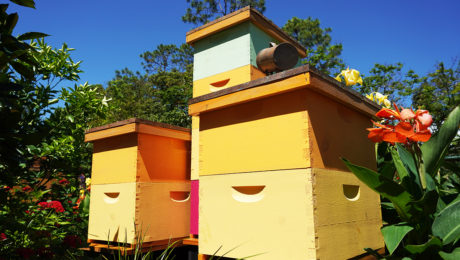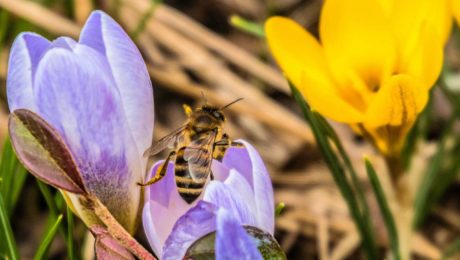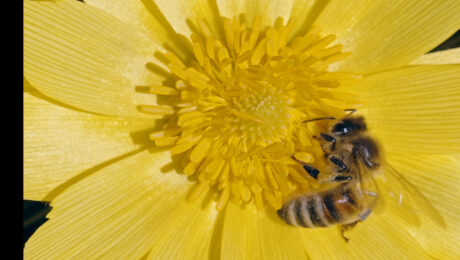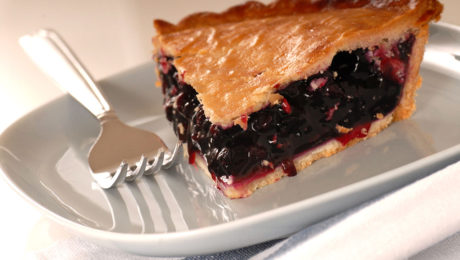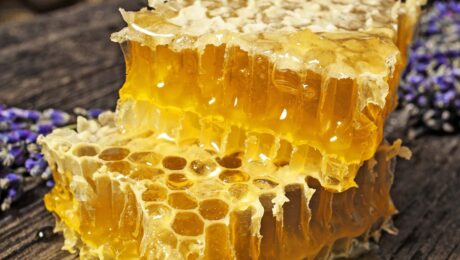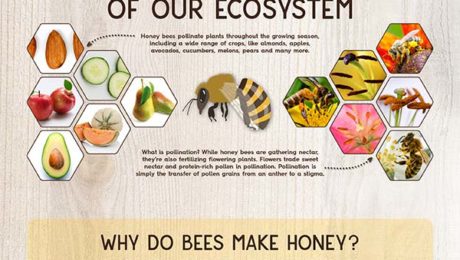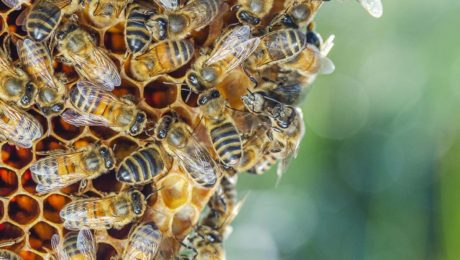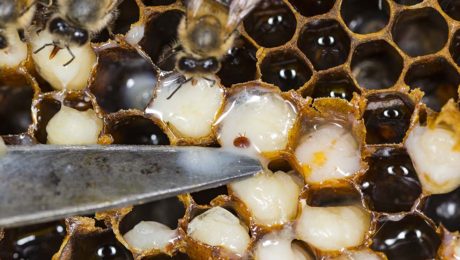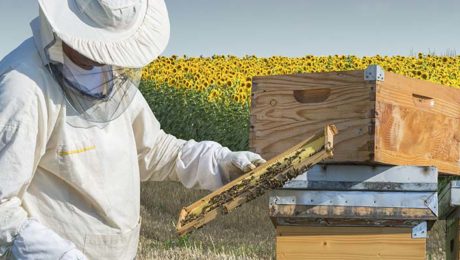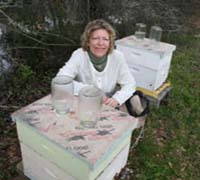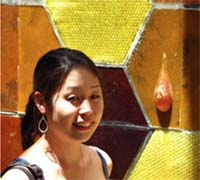Estimated reading time: 1 minute
Beekeeping Tips for April
Bees are roaring, new bees are humming with orientation flights and Drones are on the hunt. This is when swarming is at an all time high. Swarming generally occurs right before the heavy “Honey Flow”.
Drones are fully mature for mating and Queen Cells are hatching. Love is in the air. Overcrowded hives need more room so additional equipment should be placed on top of these hives to allow space for brood rearing and honey storage.
The honey flow has started when bees are coming in heavy. This is noticeable by the dip that the workers make upon entering the hive entrance. They are carrying in fresh nectar to process into honey.
April Tips
- Watch for swarms
- Catch the swarms
- Watch for full boxes and keep adding empty boxes
- Have additional equipment ready to house more swarms
- Attend bee meetings
- Update “Bloom Calendar”
Estimated reading time: 1 minute
Beekeeping Tips for February
The Queen still remains in the cluster and as the days become milder she begins to lay more eggs.
The previous protein (Pollen Patty) is used to feed young larva. These bees will hatch out of the cell in 21 days.
When young bees are being raised and days are warm, the bees will consume more food. At this time, the cluster will begin to grow in size.
A Varroa Mite, Foulbrood inspection should be done and a proper evaluation of “Queen Activity”.
By Mid February, you should see bees carrying natural pollen into the hive. When this occurs, the Queen will also begin to lay drone Eggs (Unfertile eggs) these drones will hatch in 24 days.
February Tips
- Check food stores (pollen and honey)
- Treat for Varroa Mites or Foulbrood if needed
- Begin a “Bloom Calendar” to document pollen and nectar
- Attend Bee Meetings
- Assemble Equipment
- Order Queens
Beekeeping Tips for January
During colder weather, the Queen is surrounded by thousands of worker bees. This is considered the “Winter Cluster”. You should not disturb this cluster, only open the hive and work bees when the cluster is loose.
Activity will be apparent on warmer days (45-50 degrees), this is when bees are taking cleansing flights. These days are acceptable for colony inspection. If feeding is needed, choose a feeding method that is near the bees so they can feed even when clustered. If the colony needs protein, a pollen patty may be placed directly over cluster of bees.
January Tips
- Check food stores (Pollen & Honey)
- Check for proper ventilation
- Attend bee meetings
- Assemble bee equipment
- Order Bees
Check Out Our Other Blog Posts on Beekeeping
These crisp mornings means we’re just beginning to enjoy all that fall has to offer. Beekeepers know that the cold weather means even less bee activity will send the honeybees back into cluster.
As fall swings into full force here are some tips to help you and your bees make it safely through the upcoming winter.
November Tips
- Attend Bee Meetings.
- Make sure equipment is stored properly to stop wax moth damage.
- You can feed syrup when the temperature allows (45-50 degrees).
Check Out Our Other Blog Posts on Beekeeping
Beekeeping Tips for September
Hive population continues to drop and Drones start to disappear. The Queen is laying fewer eggs. Some or all colonies may need feeding. Some or all colonies may need Re-Queening. Pollen should only be fed dry in outside feeders or mixed in syrup. No patties should be fed due to increased small hive beetle activity.
September Tips
- Feed if necessary (especially if re-queening) Pollen & Syrup
- Equalize colony strength
- Continue Mite Evaluations
- Attend Bee Meetings
- Update “Bloom Calendar
Check Out Our Other Blog Posts on Beekeeping
Beekeeping Tips for August
The colony’s growth is diminishing in numbers and the honey flow is coming to an end.
When bees stop producing honey, remove all honey supers. (Except one !) Remember to leave one full super of honey for the bees. This is what they will live on during the winter.
No more chance of swarming and the honey dearth will appear. Weaker colonies may get robbed of their honey so entrance reducers should be placed on weak colonies or move weak colonies to another bee yard.
The Varroa Mite levels are high now and an evaluation of Mite levels should be maintained during this time of year. If you determine mite levels are too high, a intergrated pest management (IPM) practice should be added to your list of beekeeping chores. A good product for Varroa mite treatment is Apivar.
Some colonies may need food and some small clusters may need additional frames of brood to increase bee numbers. Check for failing Queens and Re-Queen.
August Tips
- Remove Honey
- Remove empty supers
- Check for mites (medicate if needed)
- Feed weak colonies (Pollen & Syrup)
- Re-Queen bad Queens
- Equalize colonies
- Order More Queens
- Attend Bee Meetings
- Update “Bloom Calendar”
Check Out Our Other Blog Posts on Beekeeping
Beekeeping Tips for July
This is a “Hot and Humid “month and the bees will cluster on the outside of the hive to cool off. They will continue to make honey, weather permitting and beekeepers should start to remove ripe honey.
Remember to leave enough honey for the bees. If you remove all the honey, the stress level of the bees elevates and could cause an unhealthy colony. If weather conditions are too dry, a collapse could occur due to starvation. Remember to keep enough empty room for the bees when they come inside. Perform a Queen check and mark colonies for Re-Queening.
July Tips
- Remove Honey
- Leave enough honey for the bees (one full super)
- Keep at least one empty super on top
- Extra ventilation
- Order Queens
- Update “Bloom Calendar”
Check Out Our Other Blog Posts on Beekeeping
Beekeeping Tips for June
Colonies that did not swarm will be boiling over with bees and the “Honey Flow” continues. Keep up swarm inspections and continue adding additional space as needed.
Spring honey sources start to fade and a short honey dearth may happen between blooming cycles. Rain and weather conditions affect the summer nectar sources greatly. Under good conditions, the bees will continue to make honey. The start and stop honey flow will sometimes cause a few “After Swarms”.
The pace of honey production slows a bit and the Queen starts to lay fewer eggs. Fully Capped Honey Supers may be removed and extracted.
June Tips
- Watch for Swarms
- Keep adding empty supers as needed
- Remove Fully Capped Honey
- Attend Bee Meetings
- Update “Bloom Calendar”
Beekeeping Tips for May
The hive is working at top speed. Beekeepers hustle to keep up with the working bees by adding empty boxes underestimating how much equipment you need could cost you a honey crop and could enhance the swarming impulse.
Make sure to keep an empty box on top during this time of year. Swarming continues as new bees continue to overcrowd colonies.
May Tips
- Watch for Swarms
- Apply empty Supers
- Attend Bee Meetings
- Update “Bloom Calendar”
Other Related Articles
Estimated reading time: 1 minute
Beekeeping Tips for March
This is a critical time for starvation. The young bees are hatching daily and the size of the colony increases by hundreds if not thousands per day. The worker bees are beginning to forage and drones begin to appear.
As the days grow longer, the Queen increases her rate of egg production and colonies wishing to swarm may start to raise swarm cells and colonies with failing queens may start supersedure cells. These will hatch in 16 days.
Weather permitting, a few early swarms could occur in March. Food stores are being consumed at a rapid rate. Natural Pollen is coming in rapidly but cold, windy weather can affect nectar sources so a close watch on food stores is critical.
March Tips
- Check honey stores
- Re-queen failing Queens
- Make sure all medications are removed as specified on label
- When hive body is full of bees add Honey super
- Attend Bee Meetings
- Update “Bloom Calendar”
The weather is getting cooler and trees are just beginning to change to their brilliant fall colors.
While you’re beginning to enjoy the fall season, it’s a great time for beekeepers to continue managing your hives to ensure they survive the upcoming winter.
October Tips
Continue to combine weaker colonies and make “double sure” all queens are accepted and present. Queenless colonies should be combined with queen-right colonies.
This is the time of year to feed as much syrup as you can get them to take so they can insulate the brood nest with honey.
Replace broken equipment and make sure they have good tight hives to survive the cold winter months. Not much bee activity.
- Combine the weak
- Equalize bees
- Repair or replace bad equipment
- Attend Bee Meetings
- Review “Bloom Calendar” for next season.
Check Out Our Other Blog Posts on Beekeeping
Beekeeping is an ancient practice that has grown in popularity in recent years, especially in the US. In addition to producing delicious honey, bees play an important role in pollinating plants and maintaining environmental balance – bees are indeed life sustaining.
In this blog post, we’ll explore the fascinating world of bees in America and highlight their benefits to humans and the environment. We will explore the history of beekeeping, the importance of honey bees, the development of beekeeping in the United States, and steps to start your own apiary.
A brief history of beekeeping:
Beekeeping dates back thousands of years and is practiced by civilizations around the world. The ancient Egyptians, Greeks and Romans prized bees and their honey. European settlers brought honey bees to the New World, where they thrived in a variety of North American ecosystems. But it wasn’t until the mid-1800s that beekeeping became a commercial enterprise in the United States.
The Importance of Honeybees :
Honeybees are vital pollinators, playing a key role in the reproduction of flowering plants. Approximately one-third of the world’s food supply depends on pollinators, with bees being the most important contributors. They transfer pollen from the male parts (anthers) to the female parts (stigma) of flowers, allowing fertilization and subsequent fruit and seed production. Without bees, our food system would suffer immensely, leading to reduced crop y
Development of beekeeping in the United States:
In recent years, beekeeping has grown in popularity throughout the United States. This increase can be attributed to a number of factors, including increased awareness of the importance of factors to pollinators, the rise of organic agriculture, and a willingness to develop practices that will go away so sustainable Urban beekeeping has also flourished, with rooftop apiaries and community gardens providing ideal habitats for colonies and limited biodiversity.
Benefits of Beekeeping:
Beekeeping offers a wide array of benefits, both for individuals and the environment. Here are a few key advantages:
a) Honey Production: Beekeepers can enjoy the sweet reward of their labor by harvesting honey. Raw, local honey is prized for its unique flavors and potential health benefits.
b) Pollination: By keeping bees, individuals contribute to the overall health and productivity of surrounding ecosystems. Increased pollination leads to better crop yields, improved biodiversity, and a healthier environment.
c) Environmental Stewardship: Beekeeping aligns with sustainable practices by promoting biodiversity and supporting healthy ecosystems. Bees play a critical role in preserving plant species and promoting overall ecological balance.
d) Educational Opportunities: Beekeeping provides an excellent opportunity for education and awareness. By sharing the joys and challenges of beekeeping, individuals can foster a deeper understanding and appreciation for these remarkable insects.
In conclusion, beekeeping in the United States is not just a sweet endeavor for honey production but a vital practice for the sustainability of our environment. Bees, with their remarkable pollination capabilities, ensure the reproduction of flowering plants, making them essential for food production and ecosystem health.
The history of beekeeping dates back centuries, and its growth in recent years reflects a growing recognition of its importance. Beekeeping offers numerous benefits, including honey production, improved pollination, environmental stewardship, and educational opportunities.
As we continue to face environmental challenges and the decline of pollinators, beekeeping serves as a beacon of hope, demonstrating how individuals can contribute to the well-being of our planet.
By embracing the captivating world of bees, we can not only savor the fruits of their labor but also cultivate a deeper appreciation for the delicate balance of nature and our interconnectedness with it.
So, let’s celebrate the buzzing wonders of beekeeping and continue to support the thriving beekeeping community across the United States.
Honeybees are some of the most important insects on our planet. Not only do they produce honey, but they are also key players in the pollination of many of our food crops, including fruits, vegetables, and nuts. Without honeybees, our food supply would be severely impacted, making them a vital part of our ecosystem. In this blog post, we will explore how honeybees pollinate and their crucial role in the process.
The process of pollination occurs when pollen from the male part of a flower (the anther) is transferred to the female part of the flower (the stigma). This transfer of pollen is what enables the fertilization and development of seeds and fruits. Honeybees are particularly efficient pollinators because of their unique biology and behavior.
Honeybees are attracted to flowers by their bright colors and sweet fragrances. Once they land on a flower, they use their long, tube-like tongue (proboscis) to sip nectar from the flower. While they are feeding, the bees’ fuzzy bodies become coated with pollen from the anthers. The bees then transfer this pollen to other flowers as they move from plant to plant.
The process of pollination is aided by the behavior of honeybees. When a honeybee visits a flower, it will often land on the same spot on the flower, allowing for maximum transfer of pollen. Honeybees also have an innate sense of direction, which allows them to navigate to and from flowers with ease, increasing the chances of successful pollination.
Another reason why honeybees are such effective pollinators is that they are social insects. A single colony of honeybees can contain tens of thousands of bees, and they work together to gather food and care for their young. This means that a single honeybee can visit many flowers in a short period, maximizing the amount of pollen that is transferred.
While honeybees are an important part of the pollination process, they are not the only insects that pollinate flowers. Other bees, wasps, butterflies, moths, and even some species of flies also play a role in pollination. However, honeybees are particularly important because they are the most effective and efficient pollinators, and they can pollinate a wide variety of plants.
Honeybees are crucial to the process of pollination, which is essential for the production of many of our food crops. Their unique biology and behavior, including their attraction to flowers, innate sense of direction, and social nature, make them particularly efficient pollinators. Protecting honeybee populations is crucial for ensuring a stable and sustainable food supply for future generations.
Allergy sufferers know this time of year all too well. It’s ragweed season.
It’s also the time of year when goldenrod is blooming. And, honeybees love goldenrod!
Ragweed and goldenrod look similar. However, ragweed creates airborne pollen that many people are allergic to, while goldenrod does not.
Goldenrod is one of those plants that everyone knows, but no one can identify – or so it seems. One thing is certain though – honey bees love it!
In fact goldenrod is a key protein source for honey bees in the fall. This year, many areas will have an abundance of goldenrod due to all of the recent rains.
So, please don’t cut the goldenrod – leave it for our honey bees to feast on!

Flowering ragweed plant growing outside, a common allergen
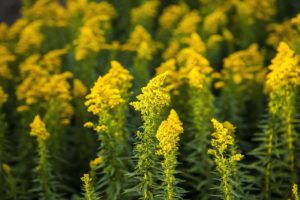
Goldenrod, a key protein source for honey bees.
Beekeepers have to move their bees sometimes to take advantage of an additional honey flow. Unfortunately sometimes they have to move bees because of Bears which could be prevented with the use of an electric or solar bear fence.This solar bear fence is a very good option.
Moving bees can be a challenge and there’s a bit of preparation that has to take place before you start to move colonies from one place to another. Make no mistake moving bees is very hot work and hydration for the beekeeper is the first thing to consider. You may also want one of these nifty neck cooling systems.
Bees navigate by the sun and return to the hive at the end of the day. That is when a beekeeper can install a moving screen.
The use of a flashlight may be required, but a very small light, like this one, is better since bees are attracted to light.
Secure supers and hive together if needed with a good quality tape or strap. On those long trips where you may have to stop for fuel or stop at a rest area Bee nets are another safety tool. Bee Safe.
Estimated reading time: 3 minutes
Choosing a Bee House?
Choosing bee equipment can be a very daunting task. This applies to all aspects of the hobby from protective gear to beekeeping tools and even the actual woodenware that houses the colony. The honeybees themselves don’t care very much about the exact type of equipment you choose as long as it meets their basic requirements. They like a home that is large enough and non-drafty (like a nice hollow tree ) or maybe even the boxing on a human’s house!
Let’s talk a bit about choosing the wooden hives for your bees. Specifically, the traditional Langstroth box that we see most often. This setup (at its most basic) involves a bottom board (screened or wooden), a deep ( hive body) an inner cover, and a top. This will be the starter home for a new package of bees or a swarm. This deep box will usually contain 10 frames with foundation. Once the small colony has developed (or pulled out) 8 of the 10 frames of foundation into the useable comb, you have a decision to make. It is time to add more space to the colony.
In some articles, you will see a standard hive configuration that uses 2 deeps for the bees themselves. This gives them
ample room to store honey, pollen, and raise babies. Two deeps are absolutely necessary for some parts of the country that have long bitter winters. A couple of disadvantages of the 2 deep system: they are very heavy when full of honey and you have to move the top one to inspect the colony; you may make less production honey with this arrangement and you will need to be sure your colony strength stays strong. If your colony swarms and you don’t notice, you may be left with too much space for too few bees and pests may take over.
Another possibility is the use of 1 deep and 1 shallow( or medium.) With this configuration, the bees will use both boxes for honey, pollen, and brood rearing. Winter honey (for the bees) will be stored mostly in the top box. This is the most popular hive configuration used by small scale beekeepers in upstate SC. The advantages include a top box that is not as heavy to lift, it is often easier to find the queen in this small space and a medium-sized population of bees can usually patrol the area and protect the comb from pests.
On top of these 2 boxes (whichever sizes you choose), you will place YOUR shallow supers for the collection of surplus honey.
Either setup will work. And beekeepers will argue about which one is the best. The decision is yours! 😉
Happy Beekeeping
For some of us, this is our first winter as a beekeeper. Others, however, are old pros at beekeeping….. right?
Whether this is your first winter or just one of many winters as a beekeeper, we are continually learning how to hone our craft of beekeeping.
In December, the bees are in a tight cluster so do not open colonies, there is nothing you can do except hope you did everything right.
December Tips
- Read a good book.
- Give honey as a gift.
- Continue to assemble equipment.
- Order bees.
- Plan for the new year.
Check Out Our Other Blog Posts on Beekeeping
Estimated reading time: 5 minutes
The most asked question we receive is “How do you process your honey?”
There are many different ways to process honey and most of the decisions are based upon the quantity of honey to be extracted. One of the most important factors in our process is to handle the honey to preserve every single quality that the honey provides for nutritional value.
Over the last 20 years that I have been a beekeeper, I have had to make changes every year to improve. Many times I have discarded certain things like heater belts and large wax melters to improve the procedure.
Read more to learn about the Bee Well Honey process.
Step 1: Harvesting
First, the beekeeper should remove honey super from colonies in the field and this requires clean trucks and a means of protecting the honey as you travel from the weather and road debris. 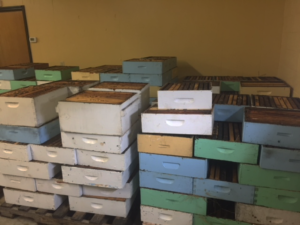 Once the honey is safely inside your honey house then the extracting process can begin. We keep our honey house between 70-75 degrees.
Once the honey is safely inside your honey house then the extracting process can begin. We keep our honey house between 70-75 degrees.
Step 2: Uncapping
There are capping forks, capping rollers, hot knives, etc. But, we use this FDA approved Silver Queen Uncapper from Cowen Manufacturing.
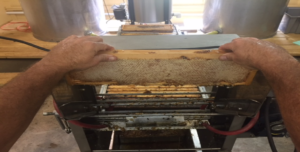
You place your frames in and the moving horizontal knives slice off the cappings.
We choose to not use the steam heated attachment to heat knives because of the honey becoming too hot and caramelizing on the knives. It works fine with no heat.
This method also makes little damage to the comb and is easy for the bees to clean and refill.
Step 3: Dealing with the Cappings
Cappings are a good place for small hive beetles to hide so it is extremely important to handle cappings quickly.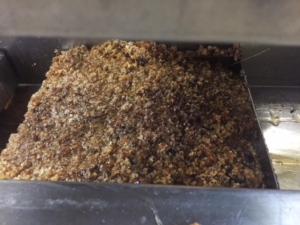
We struggled with this process for many years but, I feel we now have the best procedure for our scale production without the expense of high-tech equipment. It’s actually so much easier than all the other ways I have tried over the years and so much cleaner as well. Melting wax can be a mess.
The first part is to catch the cappings in a screened pan that sits under the uncapper.
We let the capping drain overnight.
Step 4: Spin the Cappings
After the cappings drain overnight, we place them into a Maxant Cappings Spinner. This spins all day while we extract and continues to sling the honey from the cappings.

I do love this little guy. This Maxant Mini Uncapper is the best addition to our honey house.
We don’t rush through the extracting process because we really try to get every drop and we have so many customers and tours that like to see the extracting process. It is a great teaching opportunity for us and we enjoy teaching others.
This machine is quiet and we also get a lot more honey.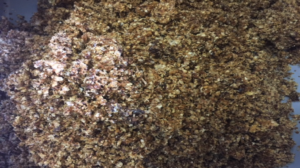
When the cappings are emptied the next morning they are dry like corn flakes.
Step 5: Melting the Cappings
We simply pour the cappings into our wax melter which actually is the first Dadant Sump Tank we owned.
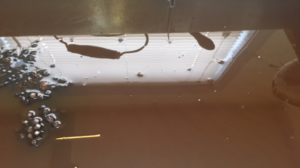
It is water jacketed and melts the wax great.
Step 6: Straining the wax for candles and blocks for retail

Step 7: After the frames of uncapped honey are placed into the extractor let them spin until you get every drop.

Step 8: The honey exits the extractor and drains into a stainless FDA approved Tank which has a float and pump.

When the honey passes through the baffles that are designed to catch the cappings and debris from the extractors and as the tank fills to the appropriate level a switch activates a Kelly Bees pump to pump the honey.
Step 9: Honey enters the settling tank.
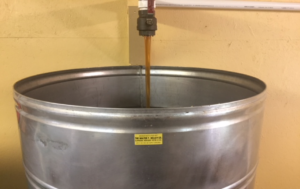
Step 10: After 24 hours the honey has settled and is ready to bottle.
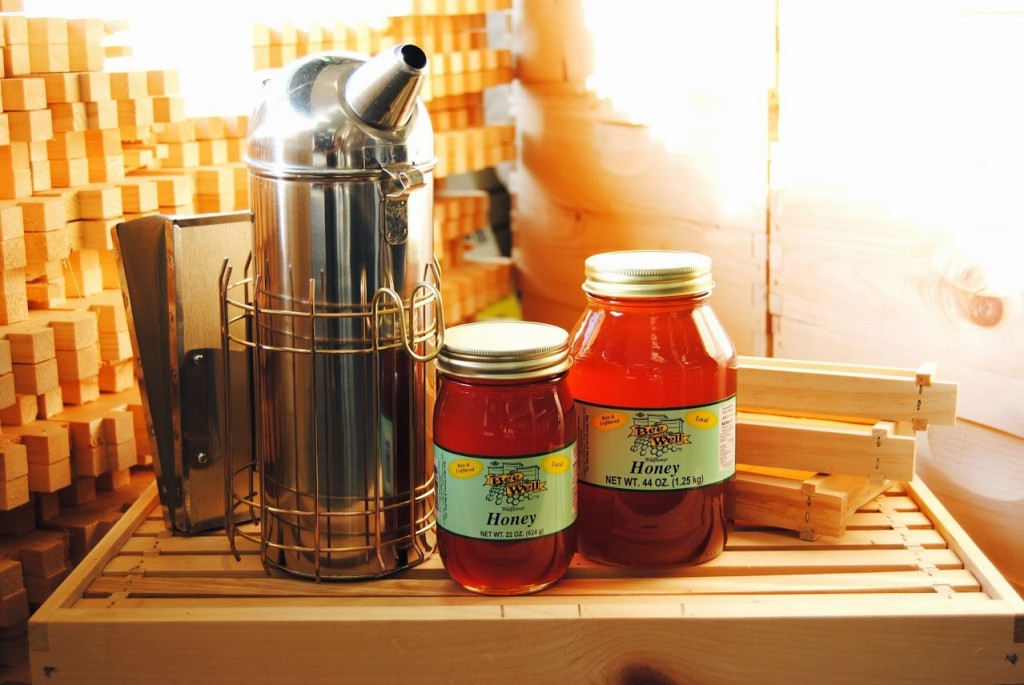
Source: The National Honey Board
Made for kids grade 2-4, these handy activity sheets are designed to teach your kids about bees, honey, and just how important they are to the world. Covering everything from beehives, pollination, how honey is made and even bee sustainability, each sheet features a fun activity kids can do at home or in school.
Estimated reading time: 3 minutes
Taking Your Bees Home
Keep bees cool and well ventilated during the drive AND once you have reached your destination. It is best to hive your bees the day you get them, but if you must keep them in the package overnight – lightly mist them with a thin sugar water solution.
Installing Your Package
Prefer to watch a video on how to install your package? You’re in luck, click HERE
A few things to keep in mind
Your hive should be properly assembled and placed in its permanent location before installing your bees. The best time of day to install a package is early evening – just before dark. This gives the bees overnight to orient themselves before heading out to work the next day.
The process
Suit up with the proper protective gear (at least a veil).
Lightly mist the screen of your package with a thin sugar water solution to start a sticky cluster effect for the bees. Remove 5 frames from your hive and slide the remaining 5 to one side. Use a hive tool to pry the wooden lid off the top of the package, exposing the sugar water can. Lift the can out of the package and set aside.
In the center of the package you will find a shipping strap that is holding the queen cage. Remove the queen cage and temporarily replace the lid on the package. This is the best time to inspect your queen. Remove the cork from the CANDY END of the queen cage. DO NOT REMOVE THE CORK FROM THE OTHER END. Place the queen cage securely between frames 2 & 3 of the five remaining in the hive. Make sure the candy end is pointing UP. Installing the queen cage with the candy end down may hinder the queen’s ability to exit the cage.
There are 2 methods for installing your package – 1: Mist your bees again and lightly tap it on the ground so that bees fall to the bottom of the package. If there is sugar water still in the can, shake some of this through the hole in the top of the package. Tap package again so that bees are in one corner of the package. Shake some of the bees in the area you placed the queen. Sit the package with the remaining bees in the empty space in the hive. Leave the open top facing up. Close your hive and leave it overnight with the package inside. Remove the package the next day. If there are any bees remaining inside, shake them out, and return the five frames you removed. 2: Follow the same steps for installing the queen, but after putting the queen between frames 2-3, gently shake the bees into the open space. Wait for them to move over to the frames & slowly replace the other 5 frames.
Feeding Your Bees
Sugar water should be prepared at a 1:1 ratio. Put a feeder on as soon as you install the package. Continue feeding your bees until they have filled their first TWO boxes – these will be their food stores for cold weather.
Checking the Queen
Wait a MINIMUM of 4 days before checking for queen release and acceptance. I f she has not been released, poke a small hole in the candy (be careful that you don’t poke bees!) and wait another few days before checking again.
A Few Disclaimers
Bees become your responsibility upon pickup. When installing your package, ensure your queen is ALIVE in the cage. You must call us THE DAY OF PICKUP if you find that your queen is dead in the cage and we will replace her. Beyond this, we cannot guarantee the success of your hive.
Questions? Contact us at (864) 898-5122 option 1 or beewellhoney@bellsouth.net
Keep learning – ask to join Bee Well Honey Bee Club on Facebook!
Estimated reading time: 2 minutes
If you are going to make a split in the spring then MAKE A GOOD ONE! It kills me when I hear beekeepers that want to make their splits before the weather is appropriate. If you make a tiny split it will struggle terribly to survive the cold temps and you risk killing them completely. Furthermore I really get steamed up when I hear about a person wanting to sell nucs too early just to try to get the jump on the “competition”. I wish they could just realize the importance of helping new beekeepers get started off successfully is the longevity of the business.
The nuc business is riddled with beekeepers trying to sell 2 or 3 frame nucs… REALLY? I have made 2 or 3 frame splits before in the summer, but I have never tried to sell such a small wad of bees to a customer in the spring.
A 4 or 5 frame nuc full of all age bees and brood has the proper ingredients and has a much better chance of survival in early spring than a 2 or 3 frame. As the season warms up and spring arrives these small splits can be made without trouble but it is very important to sell those to experienced beekeepers who know how to handle them.
A 5 frame nuc is a much better option for a beekeeper of any degree. Think about it! A Five frame nuc has everything it needs to survive if the beekeeper selling them cares anything at all about customer service and return business.
Don’t get me started on those guys that don’t stand behind their product!
Bee Well Honey Farm in Pickens South Carolina stands behind their bees and makes sure to give the customer what they are paying for.
A Five frame nuc is an established colony operating as it should with at least 3 frames of brood and 2 frames of pollen and honey.
If you don’t have all the ingredients you have not made a healthy split. Make sure your split contains 3 frames of brood and enough bees to keep that brood covered during the cold nights and days that still come in early spring then surround that brood with honey and pollen by placing full frames on each side of the brood then shake in 2 or 3 more frames of bees to make sure. This recipe will give you a healthy split queen or no queen. Good Luck!
Estimated reading time: 2 minutes
A gaggle of geese, a herd of cows, a pack of wolves, a cluster of bees…. it’s all semantics.
Honeybee Cluster
What is the cluster size? This is a common question you may hear among beekeepers when discussing the size of a honey bee colony. The honeybee cluster is the main brood area of the hive. Here the queen will lay eggs and the nurse bees will feed the young. Honey and pollen will be stored nearby for ready access. The cluster area is the “heart of the hive”, especially in winter.
Most of the year, the honeybees will be spread out over the frames going  about their daily chores. But the arrival of cool weather forces the bees to begin the clustering behavior. Because of the rearing of young, the brood area must be kept warm. When brood is present the temperature at the center of the honeybee cluster will be near 94 degrees. The bees produce heat by moving their wing muscles. As you move toward the outside of the cluster the temperature will drop. When the weather gets colder, the bees cluster tighter together.
about their daily chores. But the arrival of cool weather forces the bees to begin the clustering behavior. Because of the rearing of young, the brood area must be kept warm. When brood is present the temperature at the center of the honeybee cluster will be near 94 degrees. The bees produce heat by moving their wing muscles. As you move toward the outside of the cluster the temperature will drop. When the weather gets colder, the bees cluster tighter together.
Most beekeepers want a large cluster of bees going into late Fall. Throughout the winter, some of the older bees will die and the hive population will decrease. We want a colony to have a large enough population to sustain some loss before new bees begin to appear in late winter.
Genetics also plays a part in cluster size. Some strains of bees (such as Russians or Carniolans) will carry smaller clusters into winter and then expand the brood nest rapidly upon the arrival of early Spring.
When bitter cold weather arrives, the bees will not leave the cluster to bring honey close by. If the cold weather continues until the honey supply near the cluster is exhausted – the bees will die. This is especially a danger to small clusters. So, a honeybee colony can perish even when they have a full super of honey on top or several frames away. The honey stores have to be in the right place at the right time.
We wish the very best for all of our beekeeping friends and their bees during this winter weather!
This is a great time of year to prepare new equipment for Spring. We have everything you need: order here
Estimated reading time: 1 minute
The media buzz currently centers around a healthier style of living and making good food choices. Local, raw honey is not only a great food choice but can also be used for beauty treatments and health care.
honey is not only a great food choice but can also be used for beauty treatments and health care.
Bee Well Honey offers several varieties of honey. All of our honey is raw and unpasteurized.
Our Wildflower Honey is made from a variety of blooming plants, trees, and bushes in our region. Tulip Poplar, Holly, Maple, Blackberry, Vetch, and others give our local Wildflower honey a rich smooth taste.
We have local seasonal varieties in years that the bees and the weather cooperate. The Sourwood trees blooming along the mountainsides provide our raw Sourwood Honey. This variety is limited in supply and highly sought after by local honey enthusiasts.
Our southeast regional honey choices include Orange Blossom Honey and Tupelo Honey. Each has a distinctive taste and add an extra splash of flavor to your hot coffee or tea.
All of our honey products are raw, natural, 100% pure honey.
Buy Healthy Honey Bees!
Let’s face it guys, not every business understands the importance of integrity and ensuring the customer receives a perfect product. In fact, some self-proclaimed beekeepers are not beekeepers at all!
You know those guys who drive south to buy a trailer load of watermelons and sit on the side of the road for 2 weeks trying to sell them? Well, some wanna-be “bee sellers” do the same thing.
I hate to disappoint you, but some have realized there is money to be made by simply transporting or shipping honeybee packages. The issue is they don’t have the experience to care for them properly.
Yes, I do also see this opportunity, and appreciate that as well, but I am a beekeeper and I do know how to properly care for these honeybees in all kinds of weather conditions. I have seen some pretty sad situations where people cage the honeybees and keep them trapped in the cage for over a week! Yep, 7 days! That’s ridiculous and it leans toward cruelty in my eyes.
5 Tips for Purchasing Healthy Bees
- Find out as much information about the seller as you can. Are they reputable?
- What is the history of the bees and how long have they been held in the cage?
- Purchase hygienic bees. These bees have been bred to have the VSH (Varroa Sensitive Hygiene) trait.
- Join a local beekeeping club. Their members will be some of the greatest mentors, friends, and companions on your beekeeping journey.
- Order early.
Since opening our doors in 1999, Bee Well Honey strives to cage the bees the evening before you receive them – less than 24 hours in the cage is the goal.
The bees are shaken from various colonies and given a freshly mated queen then brought to our warehouse and handed to you early the next morning.
Think about all the things that can happen if they were to be held in the cage for days at a time: dehydration, stress, constipation, diarrhea. That’s just the start of it. They can overheat or get chilled and the list goes on and on.
Now let me be clear, you will always have a few dead bees in the package due to normal mortality and management, but if you should see inches of dead bees piled in the bottom of the package refuse them and ask for the money back.
If the business is honest and fair he will understand. I believe in keeping the bees happy and my customers happy too! You don’t have to buy them from me but look for the people that respect the bees and support them.
Bee Well this bee season!
Well, it’s August. It’s hot. And, the heat gets to me and it also impacts honeybees.
The queen has slowed down and isn’t laying as many eggs as she was in early spring. And, the bees born during the spring are starting to die.
By the waning days of summer, the honeybees have worked hard during the nectar flow. Their wings are worn and eventually, they can’t fly and they die.
Bee populations are shrinking varroa populations are growing exponentially. Actually, every 30 days varroa mites double in quantity. With the number of bees declining and varroa increasing, the health of larva and adult bees are severely impacted, and the hive collapses.
Fortunately, there is hope.
A very effective and proven mite treatment is Amitraz-based varroa mite treatment is Apivar. Sold in pack of 10 plastic strips, Apivar is capable of killing up to 99% of mites in just one easy application.
The Amitraz component lasts over six weeks and is continuously released every time the bees come into contact with the strips. It doesn’t leave any sort of harmful residues which ensures the safety of the entire bee colony. It’s also easy to use: just place one strip per five bee frames. The strips can also be used with a top bar hive setup. When not in use, the Apivar can last up to two years inside your storage.
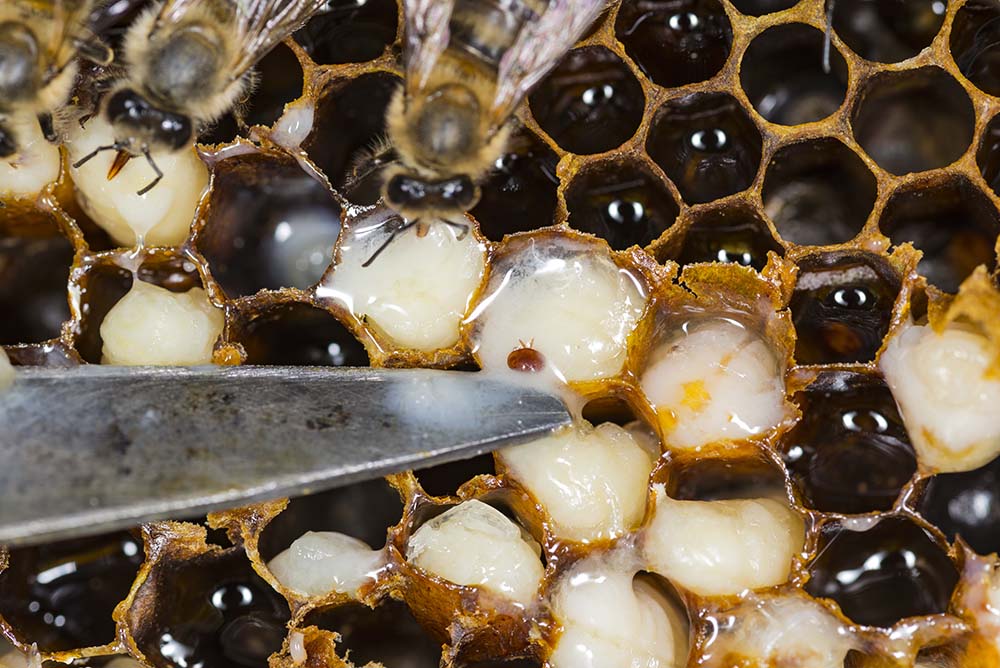
Mite in a beehive
Beekeepers sometimes have a queen to fail and for whatever reason (which could be numerous reasons) the queen is not replaced effectively by the colony. They become a queenless colony and will remain in this state operating without a queen until all of the brood baby bees have hatched out.
The reason they cannot raise a queen themselves is that they do not have an egg that is the correct age. They know for sure that they will die if they don’t have a queen and for some crazy reason, I suppose a survival instinct kicks in and the worker bees that are female and unfertile will designate and a worker bee to become their new queen.
The female worker bee begins to lay eggs randomly and multiple eggs in each cell, however all of her eggs will be unfertile. And, their colony would be destined to die. This is an extremely hard problem to solve. After the worker bees designate another worker to be the queen they are loyal to her. Even if you put in a new queen they most likely will kill her.
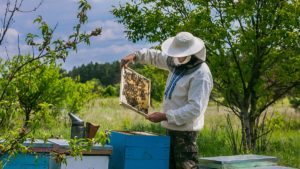
The best way I have found to solve this problem is simply take that hive of bees with the laying worker and set it on top of a healthy colony.
All of the worker bees from the healthy colony migrate to the laying worker colony, find the laying worker and kill her.
Let’s face it, honeybees can find her in a split second. At that point, the colony will start to remove the unfertile eggs from the cells and polish them so the good queen can lay fresh eggs in the cells. In 8 to 10 days those once trashy frames of laying worker brood will have good healthy capped brood. At that point, you can find the queen so you leave her in the parent colony.
Bee Well Honey,
Kerry Owen
Check Out Our Other Blog Posts On Beekeeping
Beekeeping Tips: Preparing for Moving Bees
Bee Well Honey is Open For Business: Service Impacts related to Coronavirus
We are the only Bee company still shipping Nationwide!! #1 Honeybee shipping Coast to Coast is Bee Well Honey Farm and Bee Supply Inc. 21 years in business and a nationally award-winning company.
Please note: Due to coronavirus there is no insurance on shipped bees from UPS or USPS or BWH. If your mail deliveries have been delayed in your area it is best to contact your local PO or UPS terminal for this information. If you have ordered bees previously you may ask for a refund if you wish otherwise when the bees leave our facility they are your responsibility.
Read the UPS Service Alert Here: https://www.ups.com/us/en/service-alerts.page?id=alert1
Read the USPS Service Alert Here: https://about.usps.com/newsroom/service-alerts/
We Want You for Bee Well Bootcamp
This in-depth beekeeping class covers all the crucial details of starting with bees. This course begins with a Lecture and concludes with Field Instruction.
Cost
$75
Class Schedule
March 7, 2020
10:00 am – 12:00 pm Lecture
1:00 pm – 4:00 pm Field Instruction
Lecture Includes
- How to install, feed, and medicate your bees
- Behaviors of the bees
- Detection of mites, beetles, and diseases
Field Instruction Includes
- Examine real beehives
- Hands-on interaction with the bees
Class Instructor – Kerry Owen
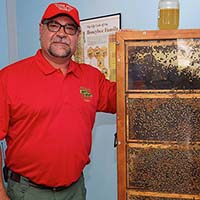
Common Sense Beekeeping Class
This beekeeping class is an in-depth discussion on the fundamental practices of beekeeping, the natural behavioral habits of honeybees, and the methods needed from a beekeeper to help the honeybees and the beekeeper become a successful partnership.
- Date: February 1, 2020
- Time: 1:00 p – 4:00 p
- Cost: $25.00
Class Covers
- Basic Equipment
- Locating Bee Yards
- Calendar Year Description of Maintenance and Responsibilities
Guided Tour
- This class includes a guided tour with Kerry Owen of South Carolina’s largest beekeeping agritourism business.
Oyster Mushroom Cultivation Workshop
Have you ever wanted to learn how to harvest mushrooms? If so, this workshop is for you.
What You Will Learn
- Overview of various cultivation techniques
- Hands on demonstration of how to cultivate mushrooms
- Attendees will be leaving this workshop with hands on experience on how to cultivate mushrooms from straw and a fruiting kit which they will assemble in class and take home where they can harvest their own mushrooms!!!
Cost: $25
Location
Bee Well Honey Bee Supply
909 W. Main Street
Pickens, SC 29671
Class Schedule
- Date: January 18, 2020
- Time: 10:00 a – 12:00 p
- Cost: $25.00
Class Instructor – Nick Tribble
Nick is a Wild Mushroom Safety Course Certificate Holder and has 4 years of detailed experience with farming/permaculture techniques. In addition, Nick is employed at Bee Well Honey Farm as a certified Bee Keeper.
Bees are necessary for about 80% of all crops that are used directly for food worldwide. But the last decade has been hard on them, reducing their numbers year after year.
I’m often asked “How can we help save the bees?” Here are five things you can do to help save the bees:
1. Plant Bee-Friendly Flowers and Herbs In Your Garden
Planting flowers in your garden, yard, or in a planter will help provide bees with forage. Avoid chemically treating your flowers as chemicals can leach into pollen and negatively affect the bees systems. Plant plenty of the same type of bloom together, bees like volume of forage (a sq. yard is a good estimate).
Good Plant Varieties:
- Spring – lilacs, penstemon, lavender, sage, verbena, and wisteria
- Summer – Mint, cosmos, squash, tomatoes, pumpkins, sunflowers, oregano, rosemary, poppies, black-eyed Susan, passion flower vine, honeysuckle
- Fall – Fuschia, mint, bush sunflower, sage, verbena, toadflas
2. Weeds Are Good
A lawn full of clover and dandelions is not just a good thing—it’s a great thing! A haven for honeybees (and other native pollinators too). Don’t be so nervous about letting your lawn live a little. Wildflowers, many of which we might classify as weeds, are some of the most important food sources for native North American bees.
3. Buy Local, Raw Honey
Buy local, raw honey that is from hives that are not treated by chemicals. It can be hard to find out what is truly “local” and truly “raw”–and even harder yet to find out what is untreated. Bee Well Honey exclusively sells local, raw honey.
4. Bees are Thirsty Little Creatures. Leave a Small Basin of Fresh Water Outside Your Home
They will appreciate it!
5. Learn How to be a Beekeeper
Find a local honey bee association that offers classes. Click here to visit the South Carolina State Beekeepers resource page to find an association near you.
One of the many questions we receive is “How to Split a Hive?” As the name implies, a split literally splits one colony into two. By taking a strong, vibrant colony you create two.
Aside from the obvious benefits for expanding your beekeeping world, if your existing hive is overcrowded the bees will swarm. Splitting a hive can prevent swarming.
This video walks you step by step of how to split a hive.
New to beekeeping? Unsure about how best to install a package of bees? This video guides you step by step through the process of installing your package of bees and queen so that your first beekeeping activity is a pleasant and thrilling experience!
Bee Well Honey is a family-owned and operated
We took a microphone with us to the ABF Annual meeting in Myrtle Beach.
Lots of great conversation!
In this episode some quick insights on the need for planting pollinator friendly vegetation.
Segments include Joel Hausser from Tennessee and Dr. Marla Spivak from the University of Minnesota.
Special thanks to the ABF! (which I think I AFB’d once or twice)
BEE WELL!
Paul/Kerry
On this National Farmers Day, I walked outside to peak down over our pollinator garden this morning, I was truly thankful for the recent rain. I then realized that the rain would also affect my team of beekeepers to do their day to day activities.
About that time my son Stetson, who is the young leader of the pack, saw me shaking my head and hollered up the hill to say “What?” and I replied RAIN!!! He knew I was concerned about the plan to go feed and service the 2000+ colonies scattered across the Southeast. Stetson replied, “It’s just Rain”. You see what I did not know at that time that Stetson and the guys had already Googled the weather and knew it would stop in 7 minutes. ARE YOU KIDDING ME?
It was at that moment that I was lost in time… I felt the rain and I felt the mud under my feet and was already picturing the trucks stuck in the field and was ready to abort the mission.
I couldn’t help but laugh, and I started thinking about the changes in technology since I began Bee Well Honey Farm 20 years ago.
Now I have websites, Facebook, Instagram, Twitter, and I think some 80 more social media type accounts.
I also never thought I would be blogging and teaching my craft online.
It really is kind of amazing when you think about it.
One of the best things is the ability to search for ideas and products online. I really like being able to search “How to make candles” and learn the process in minutes or at least get the idea of how to begin and try the process until I eventually get it right.
The most valuable part of the web is the ability to connect with consumers to buy your products. Our online sales have skyrocketed since we spent the time and money to make it easy for consumers to buy our products.
In the past I would fill my back seat full with our honey and drive around looking for customers – now they come to us from all over the US.
I still like the one on one exchange between the beekeeper and the customer, but now when we do it everyone goes to a store celebration or a Farmers Market and you sell a jar at a time. The online connection is, as I said, amazing.
It’s been 7 minutes and the sun is now shining..the rain is gone. Just blows my mind LOL.
Happy National Farmers Day!
Have you ever had honey in your pantry that is ‘crystallized’ and feels ‘gritty’? What you are feeling is the little granules starting to form when honey naturally granulates or hardens. It doesn’t mean it is going bad. In fact, that is nature’s way of preserving its finest sweetener.
Creamed honey is a type of honey that’s been processed in a special way. The reason you do this is to promote the formation of small sugar crystals and prevent large ones, and this ensures the honey will remain creamy and easy to spread. Creamed honey can be used as a sweetener in drinks and baking, but it’s also great as a spread on toast, crackers, and other treats.
Creamed Honey Recipe
- 16 ounces (454 g) Bee Well Honey
- 1½ ounces (45 g) Seed honey
- 1 teaspoon (2.6 g) cinnamon (optional)
- 1 teaspoon (5 g) herbs (optional)
- 1 teaspoon (5 ml) vanilla (optional)
Use honey that’s already been creamed. The process of making creamed honey involves adding seed honey to liquid honey. Seed honey has already crystallized, so it promotes more crystallization in fresh liquid honey. One of the seed types you can use is honey that’s already been creamed.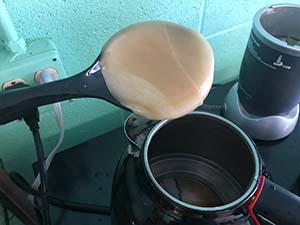
- Creamed honey can be purchased in many grocery stores, health food stores, at farmers markets, and at bee farms.
- Creamed honey will sometimes be labeled whipped, spun, or set honey.
Use crystallized honey powder. Another seed you can use to make creamed honey is the hardened sugar crystals from previously liquid honey. Unprocessed honey naturally crystallizes over time, and you can collect this hardened honey and powder it to use as seed honey.
- Collect the crystallized honey from an old jar of honey. Place the crystals in a blender or food processor and grind the crystals into a fine powder. This breaks down the large crystals, and these will seed the growth of more small crystals in your new batch of creamed honey.
- You can also grind the crystallized honey using a pestle and mortar
Make your own honey crystals. If you don’t have creamed honey or an old jar of crystallized liquid honey on hand, you can make your own crystals with a jar of new honey that hasn’t been pasteurized or filtered.
- Take the lid off the jar of honey. Place the jar in the fridge. Reduce the temperature of the fridge to 58 F (14 C) or lower.
- Over the next few days, the sugar in the honey will gradually crystallize. Collect the hardened crystals once you have enough for a seed to make your creamed honey.
- Process the crystallized honey in a blender, food processor, or with a pestle and mortar to turn it into a fine powder
Gather your ingredients. There are two main types of honey available on the market: raw unfiltered honey and pasteurized honey. The pasteurization process kills pollen, spores, and bacteria, and you can do this on your own by heating the honey before adding the seed. To make pasteurized creamed honey, you’ll need: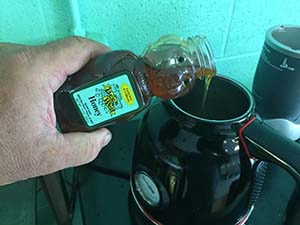
- Steam Kettle
- Your liquid honey and seed honey
- A medium saucepan with a lid
- A rubber spatula or wooden spoon
- A candy thermometer
- A sterilized storage jar with a lid
Heat the honey. Pour the liquid honey into the saucepan and heat it over medium-high heat. Use the candy thermometer to monitor the temperature, and bring the honey to 140 F (60 C).
- Along with killing bacteria, heating the honey will also remove any large crystals that have already formed. If large crystals form rather than small ones, the honey will harden instead of becoming smooth and spreadable.
- To make a larger batch of creamed honey, increase the ratios of liquid honey and seed honey. For the seed honey, use about 10 percent of the quantity of liquid honey.
Stir frequently. To prevent burning, stir the honey regularly as it heats. While it’s heating up, you can also add additional flavorings and ingredients to the honey if you like. You can gradually add in:
- Cinnamon
- Vanilla
- Dried herbs, such as thyme or oregano
Cool the honey and skim the bubbles. When the honey reaches 140 F (60 C), remove it from the heat. Set it aside and let it cool to about 95 F (35 C). As the honey cools, bubbles will rise to the surface. Skim the bubbles and the foam off the top.
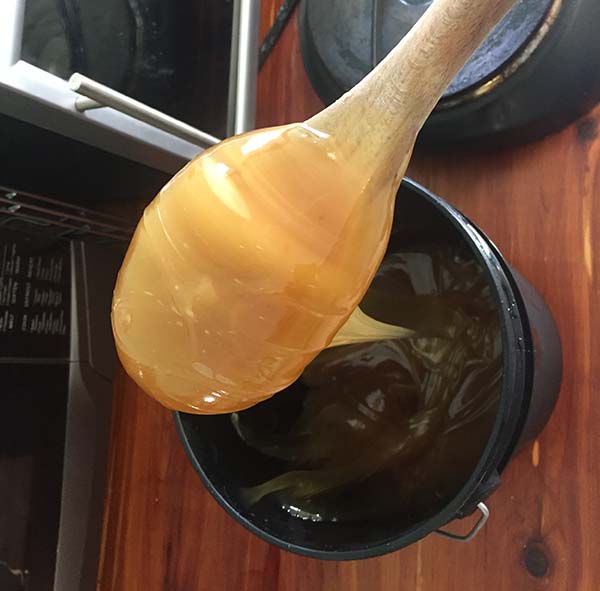
Add the seed. While the honey is still between 90 and 95 F (32 and 35 C), add in the seed honey. Stir gently until the seed honey has been fully incorporated into the liquid honey.
- It’s important to stir gently so that you don’t create more air bubbles
Let the honey rest. Place the lid on the saucepan and set the honey aside to rest for at least 12 hours. During this time, more bubbles will rise to the surface, and the seeding process will begin.
- Over time, the small sugar crystals in the seed honey will help more small crystals grow. As the crystals spread, the entire mixture will turn to creamed honey.
Skim off the bubbles before bottling. Once the honey has had time to rest, skim off any bubbles that have risen to the surface. Transfer the honey to a sterilized glass or plastic container and screw on the lid.
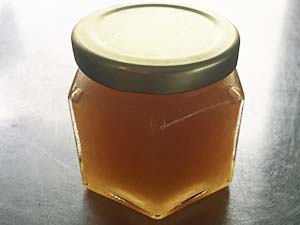
- It’s not absolutely necessary to remove the air bubbles from the honey, but it will improve the appearance of the final product.
Store the honey somewhere cool for about a week. Transfer the honey to an environment that constantly remains around 57 F (14 C). Leave the honey to crystallize for at least five days, and up to two weeks.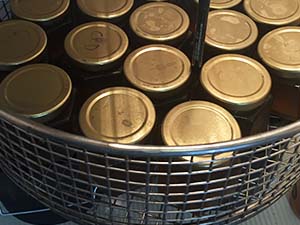
- Good places to store the honey during this time include a basement, cold cellar, refrigerator, or cold garage.
- Once the honey is ready, store it in the cupboard or pantry.
Growing a successful honey business takes more than honey bees and supplies. Growing a successful honey business takes hard work, dedication, and passion. This is how to start a business.
Entrepreneurs are often asked, “How to start a business?”
Owners must hire the right staff, advertise their business, and find the best location to attract hungry crowds. A typical day may have the following to-do list:
- Order supplies
- Create a budget
- Perform hands-on customer service
- Schedule employee shifts
- Commission work for the company website
- Respond to customer concerns on feedback sites like Yelp
- Ensure all food and beverages are being made responsibly and up to company standards
Ordering must anticipate higher volumes of customers without wasting too much product. To a certain extent, an owner may be able to distance themselves from the actual production of the honey, but it helps to have a full understanding of all sides of the business.
What is the target market?
Owners need to attract a crowd who is willing to pay for a premium experience when they want a delicious product. The ideal customer would be someone who lives near the store who will consistently look to your business as their go-to for quality treats. You may also want to attract those who primarily want a coffee shop, but with a bit of a twist.
How does a Honey business make money?
A honey company serves a premium to paying clients in a variety of forms (e.g., in jars, cases, buckets, barrels, etc.) Honey companies may also offer other products, such as bee supplies or bees.
As the owner, you will need to account for location costs (rent, inflation, etc.), employee salaries, and the cost of producing the product. They will then have to determine a price for each individual item that will cover these costs and allow for a profit. It is not recommended that a honey company try for a budget angle due to the cost and effort to make the products.
What is the growth potential for a honey business?
The amount of people purchasing honey has increased dramatically and continues to achieve modest gains yearly. The amount of honey purchased in stores and from neighborhood businesses is predicted to remain strong, however, the overall trends do not necessarily point to growth spikes as high as were seen a few years ago.
The most successful shops are rooted in innovative flavors (e.g., infused, varieties, creamed etc.) and a variety of packaging ( e.g. straws, glass, plastic) Honey companies are most likely to do well in large cities where residents are always looking for a little novelty. As long as the business can change with the times, there should be plenty of room for growth.
Getting Started
What are some skills and experiences that will help you build a successful honey business?
Owners should have a lot of experience in the foodservice industry, including customer service, production, and management. They should have a good understanding of what it takes to give customers a consistent experience no matter when they walk through the door. A formal education such as an MBA or culinary school will certainly help, but the real value lies in having a thorough understanding of how each employee works together to form a cohesive team that can produce and serve superior honey.
What are the costs involved in opening a honey business?

Besides rent and employee salaries, owners will need to register their business and obtain all permits from both the state and local government. A health inspector will need to visit before approving the business, too. The total for these fees vary widely based on where you are and how much profit you expect to make, so the range can be anywhere from a several hundred dollars to up to $8,000 or more. Typically, you can expect to pay less if you’re in a less desirable area.
Owners will need commercial insurance for things like workers’ compensation and liability protection. Average annual commercial insurance costs for food-service small businesses are around $3,000, but each business is judged individually. Initial supplies are the honey extracting equipment (uncappers, extractors, pumps, bottles etc.), cash register and a display case. A basic cash register will only cost a few hundred, but you may want to invest in better technology which will put you closer to $1,000. Owners will need a computer to keep track of finances and schedules.
How to Start a Business?
Once you’re ready to start your honey business, follow these steps to ensure that your business is legally compliant and avoid wasting time and money as your business grows:
- Plan your business. A clear plan is essential for success as an entrepreneur. A few important topics to consider are your initial costs, your target market, and how long it will take you to break even.
- Form a legal entity. Establishing a legal business entity prevents you from being personally liable if your honey business is sued.
- Register for taxes. You will need to register for a variety of state and federal taxes before you can open for business.
- Open a business bank account. A dedicated checking account for your honey business keeps your finances organized and makes your business appear more professional to your customers.
- Set up business accounting. Recording your various expenses and sources of income is critical to understanding the financial performance of your business. Keeping accurate and detailed accounts also greatly simplifies your annual tax filing.
- Obtain necessary permits and licenses. Failure to acquire necessary permits and licenses can result in hefty fines, or even cause your business to be shut down.
- Get business insurance. Insurance is highly recommended for all business owners. If you hire employees, workers compensation insurance may be a legal requirement in your state.
- Define your brand. Your brand is what your company stands for, as well as how your business is perceived by the public. A strong brand will help your business stand out from competitors.
- Establish a web presence. A business website allows customers to learn more about your company and the products or services you offer. You can also use social media to attract new clients or customers.
What are some insider tips for jump-starting a honey business?
Start with a variety of flavors, and over time you can weed out ones that aren’t popular. Offer samples as though your business depends on it — because it does. Your job is to get customers hooked on a certain taste they can’t find anywhere else. You may also want to shell out more money for employees who really know their way around customer service. New businesses will need to make a stellar first impression, and it will be hard to find employees willing to go the extra mile if you’re only paying minimum wage.
Growing Your Business
How to promote & market a honey business
The best way to promote your business is through word of mouth. To get people to the first batch of people coming in though, you’ll likely have to do a Grand Opening, complete with free honey tastings and lots of advanced party planning. The more attention you can attract at the beginning, the more likely it is that excitement will continue long after you’ve cut the ribbon. You’ll want to monitor the Yelp page carefully. The honey business website should be easy to navigate and have excellent content. Advertise to customers about company values too. For example, those willing to pay a few bucks more for a single jar expect their ingredients to be sourced locally, sustainably, and responsibly.
How to keep customers coming back
The best way to retain customers is to deliver the best possible product and service at all times. The more attention put into every touchpoint between the business and the customer (including in-person, over the phone, and online), the more likely it is that customers will continue to spread the word about the honey business. Collect feedback about every aspect of the business from measures like surveys, reviews or conversations, and then adjust the business as need be.
How and when to build a team
Building a team is all about defining the core qualities of employees. Your employees should be able to work under extreme pressure, and they always are looking for ways to make customers happy. Even the most demanding and picky person can be won over by genuinely good customer service. The best time to build your team is right at the beginning, so you can form a core group of people who want to see through what they started.
Legal Considerations
State & Local Business Licensing Requirements
A honey business will need licensing from a local health department, which will vary from town to town. This is because all establishments serving food are required to pass a health inspection.
Most businesses are required to collect sales tax on the goods or services they provide. To learn more about how sales tax will affect your business, check out this guide, Sales Tax for Small Businesses.
FDA Requirements
Furthermore, any business which sells food prepared on site may be randomly inspected by the local health department on a regular basis. These inspections will check for compliance with local health laws, typically related to the prevention of food contamination. Tips for faring well on health inspections can be found here.
Music Licensing
In order to play music in a business setting, permission must be acquired from the composer or license holder. Typically, it is possible to obtain a “blanket” license allowing a businesses to play music owned by a large catalog of artists and recording studios. Such licenses can be obtained from Performance Rights Organizations, such as ASCAP or BMI. Learn more about music licensing requirements.
Certificate of Occupancy
Businesses operating out of a physical location typically require a Certificate of Occupancy (CO). A CO confirms that all building codes, zoning laws, and government regulations have been met.
- If you plan to lease a location:
- It is generally the landlord’s responsibility to obtain a CO.
- Before leasing, confirm that your landlord has or can obtain a valid CO that is applicable to a honey business
- After a major renovation, a new CO often needs to be issued. If your place of business will be renovated before open it is recommended to include language in your lease agreement stating that lease payments will not commence until a valid CO is issued.
- If you plan to purchase or build a location:
- You will be responsible for obtaining a valid CO from a local government authority.
- Review all building codes and zoning requirements for your business’ location to ensure your honey business will be in compliance and able to obtain a CO.
Reduce Personal Liability
Structuring your business as a limited liability company (LLC) ensures your personal assets are protected in the event your business is sued.
Earning Potential
How much can you charge customers?
One general rule of thumb (which differs for each owner depending on where they operate) is to charge 3 to 4 times the cost of the raw ingredients. So if one jar of honey costs $1.00, then the appropriate cost for a customer to pay might be around $3-$4.00. The same can be said for specialty containers as well. A well-maintained shop with fancy amenities can allow you to charge even more.
What are the ongoing expenses for a honey business?
Typically, an owner will have the following ongoing expenses:
- Equipment maintenance
- Employee salaries
- Ordering expenses
- Permit renewals
How much profit can a honey business make?
It’s difficult to estimate as it really does depend on location and price points. In general, you can expect about a third of the budget to go towards raw producing and a third to go to employees. The rest will typically go toward equipment and rent costs.
How can you make your business more profitable?
One easy way is to upsell your customers to larger portion sizes, specialty flavors, etc. However, you can also expand into offering bee supplies or bees, as well as cakes, pastries, and other treats you see the list can grow over time. Get more people hooked by opening up local stands at major events.
Other Posts You May Be Interested In
NEWS RELEASE – Anderson County Sheriff’s Office – Emergency Management
New cases of avian-based West Nile Virus confirmed
Anderson, SC (20 September 2018, 5:00 p.m. EDT) – Four new cases of West Nile Virus have been confirmed this week in birds found in Anderson County. The birds were located near the intersections of North Avenue and Main Street and Camson Rd. and Hembree Rd. in Anderson; Porter Road and Central Road and Cherry Street Extension and Woodhaven Drive in Pendleton.
The Emergency Management Division in partnership and coordination with the City of Anderson, Pickens County Emergency Management and Gregory Pest Solutions, the County’s pest control contractor, will be spraying affected areas within a one-mile radius of the locations where the dead birds were found.
Weather permitting, spraying will take place on Saturday night, September 22, and Sunday, September 23, and will include the placement of larvicide briquettes in standing water on public lands.
At this time, there remain no confirmed human cases of the disease in Anderson County; however, the Emergency Management Division is taking appropriate mitigation and abatement actions in the affected areas.
The water-based pesticide used during spraying does not pose a health risk to humans or animals; however, beekeepers with hives in the area should arrange to relocate hives until spraying has been completed. All local beekeeping organizations are being notified.
The larvicide briquettes placed in areas of standing water to reduce the mosquito threat should not be handled or disturbed by the public and will remain effective up to 45 days after placement.
A CodeRed message will be sent out to residents within a one-mile radius of where the infected birds were located alerting them to plans for spraying and directing them to the Emergency Management Division website for more information.
In addition, the agency will use its social media accounts as well as other county media resources to provide information about West Nile Virus and mosquito-borne illnesses.
Spraying is expected to take place late both Saturday and Sunday nights and should conclude by early Monday morning.
Residents are reminded of the most effective ways to prevent mosquito-borne illnesses, including West Nile Virus:
• Repellents help keep mosquitoes from biting. Apply insect repellent containing DEET, picaridin, oil of lemon eucalyptus, or IR 3535 according to label instructions.
• Make sure that your doors and windows have tight-fitting screens to keep out mosquitoes.
• Eliminate all sources of standing water on your property, including flowerpots, gutters, buckets, pool covers, birdbaths, old car tires, rain gutters and pet bowls.
• Wearing light-colored clothing to cover the skin reduces the risk of bites.
For additional information regarding the West Nile Virus and other mosquito-borne illnesses, as well as other important tips, follow @ACSCEMD on Facebook and Twitter or visit the following websites:
https://emd.andersonsheriff.org/wnv
http://www.scdhec.gov/HomeAndEnvironment/Insects/Mosquitoes/
https://www.cdc.gov/westnile/index.html
Do you know how much You help local businesses by sharing your experience on Social Media?
I remember when I first started trying to play in the sandbox with self-proclaimed competitors by advertising online and opening up to Social Media marketing. As a small business I tried to pay for training for employees to better educate themselves on how to manage websites and social media, but I soon found that approach not to be very successful – we got behind on the actual work we needed to do. And, in some cases, I discovered that I actually financed others to start their own businesses before they had a chance to help my business.
As a business owner you have to just take the punch and go on when that happens.
Unfortunately, the more I learned the more I realized that “pop-up” businesses that are looking for a quick buck can actually purchase things like Facebook Page “Likes” or reader “engagements and comments”.
I, too, considered trying to do some of these same things to compete, but thankfully, after digging deeper, I discovered that Facebook and Google have means of trying to protect businesses from this false presentation. However, I know of many businesses that sneak by and continue to do try these deceptive business practices.
I knew that much of what some competitors appeared to be doing in social media just wasn’t on the up-and-up. When a new business pops up and immediately has 50,000 Facebook page likes, you know in your heart that’s a scam. Does the consumer recognize it? I don’t think so.
I also found that not all website and digital marketing companies are true to their word. I took many wrong roads and lots of wasted money, before I finally settled with a company that is honest and truthful.
Focus on the Things That Matter
As small business owners, it’s hard for us to be great at everything. We have to rely on other professionals to help us learn and navigate through the social media marketing strategies and learn how to read Google analytical reports and pick the right keywords and keep them up to date…blah, blah blah!!!
You see this has nothing to do with my passion to be a beekeeper. In fact, it’s hard for me to be both.
I know many Master Beekeepers that are much smarter than me and are also good at blogging and are successful in the social media arena – awesome and great for them…Hip, Hip Hooray! However, they just don’t openly discuss how they constantly have issues with their bees dying.
You Can’t Always be Great at Beekeeping and Social Media Marketing!
I’m sure some will disagree with this sentiment, but I mean no disrespect to those that can do both. I just know for me, it’s important for our company to be solely focused on producing the best local honey possible and providing the best customer service.
How Can You Help Your Local Small Businesses?
First of all, think local, buy local! Studies show that when you buy from an independent, locally owned business, rather than a nationally owned business, significantly more of your money is used to make purchases from other local businesses, service providers, and farms — further strengthening the economic base of the whole community.
Secondly, tell your friends! And, one of the best ways to share with your friends about your experience is through social media. I hope you take the time to help us promote beekeeping across our state and beyond and introduce the public about ways to keep the honeybees alive and help us build a great agri-tourism facility in Pickens for honeybee lovers.
Please take a moment to review us by clicking on the images below:
[wp_time_to_read]
So, how does all that beautiful raw, honey get into jars and on store shelves?
After we extract our honey, it is delivered to the bottling tanks.
Step 1: Straining Process
Due to consumer protection, we recommend you strain the honey in some way.  We do not recommend filtering, we use these bag strainers to insure any unwanted particles are strained out but this still allows the good stuff like pollen particles to flow freely.
We do not recommend filtering, we use these bag strainers to insure any unwanted particles are strained out but this still allows the good stuff like pollen particles to flow freely.
Step 2: Load In Bottling Tanks
The clean honey is then safely loaded into bottling tanks. 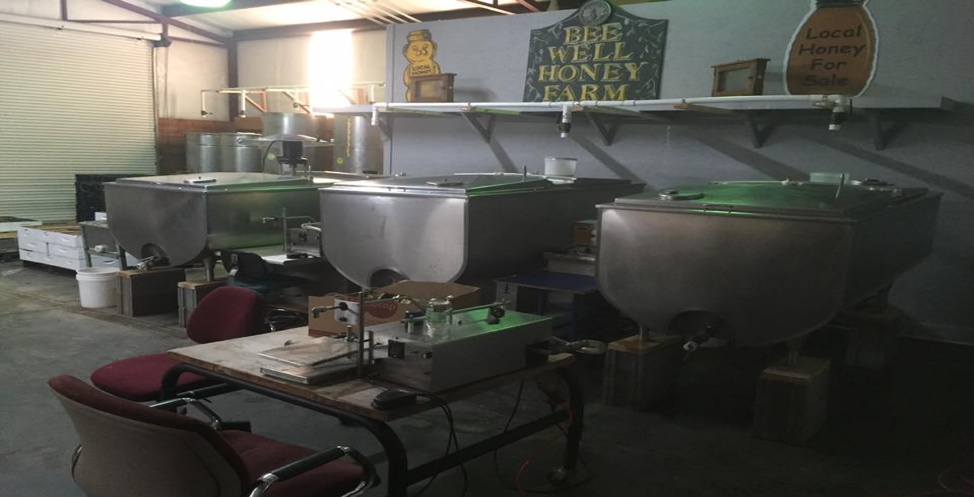 Our raw honey is heated to 110 degrees – well under pasteurization temperature. Keeping our honey under pasteurization temperature ensures our honey maintains its healthy benefits.
Our raw honey is heated to 110 degrees – well under pasteurization temperature. Keeping our honey under pasteurization temperature ensures our honey maintains its healthy benefits.
Step 3: Bottling Dates Added to Jars
The FDA and USDA require bottling to have clearly marked bottling dates or lot numbers. We use a hand-held ink jet printer to label our jars.
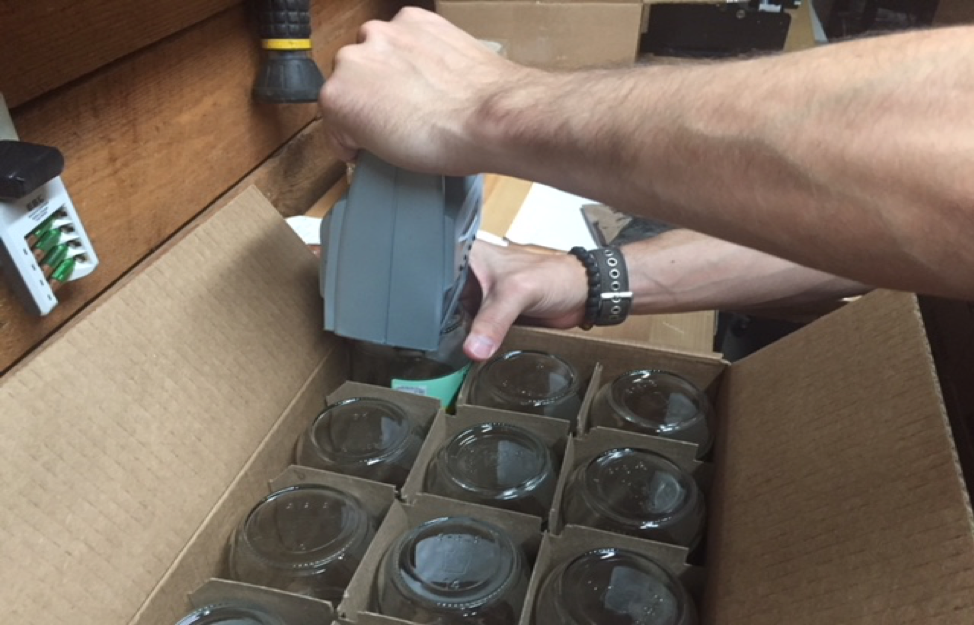
Step 4: Labeling
We apply the USDA, FDA approved labels to our jars. We love this Advent labeler.
Step 5: Filling the Jars
Now its time to fill the jarswith honey. We use two machines.: the Fill Master from Dadant and the Swienty bottler.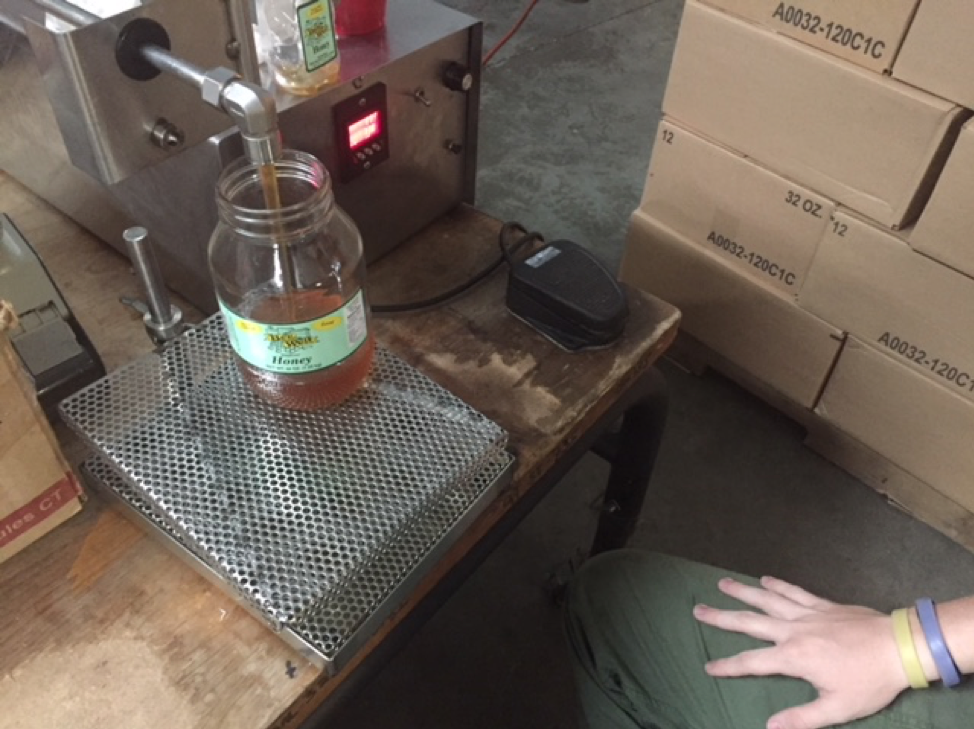
Step 6: Labeling the Boxes
We label the outside of the boxes for shipping.
Step 7: Loading the Pallets
We load the boxes on pallets and properly label the pallets for distribution.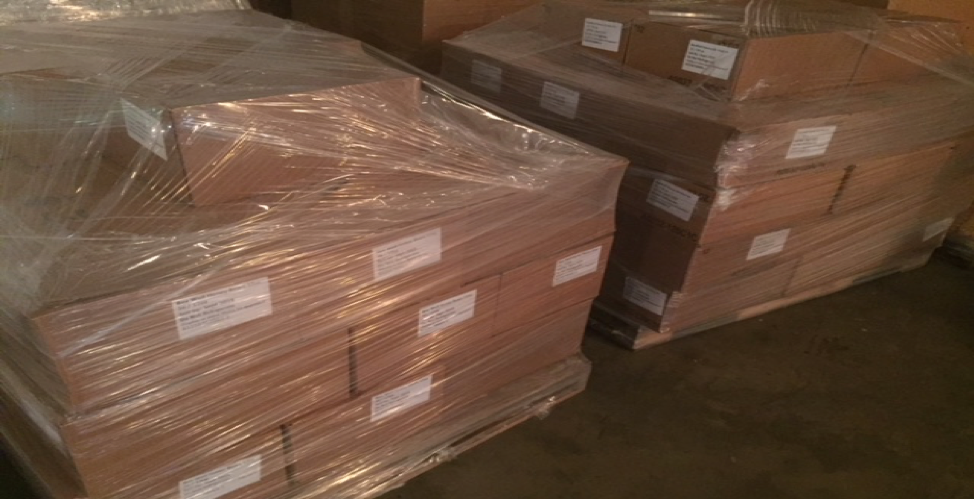
Step 8: Shipping
Pallets are checked in at our distribution warehouses and then loaded onto our trucks for distribution.
Our US DOT Certified Trucks have been inspected by FDA for safe distribution delivery to stores.
Step 8: Store Shelves
Our pure, raw, local honey on store shelves.
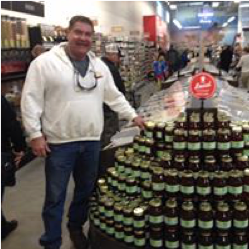
Join Bee Well Honey as we celebrate World Honey Bee Day with a Customer Appreciation Day.
10% to 50% off Storewide Wide Sale
New and Used Beekeeping Equipment Yard Sale
• Used 240 Gallon Syrup tank and motor with 100 foot hose for feeding with an extra new in box Briggs and Straton motor
• Used Better Way Wax Melter
• Used Cypress and Pine 5 Frame Nuc Boxes
• Used 200 + Baby Nuc Queen Rearing Boxes
• Used 55 Gallon Barrel pallet jack (needs minor repair)
• Used Yard Vacuum with Briggs and Straton motor
• Used Division Board feeders
and much much more!!!
-Take a Kid To A Bee Farm 9:00- 10:00
An hour of teaching our youth about honeybees, Honey and
Pollination and face painting
–The Bee Well Honey Apprentice Program Discussion Group
10:00- 12:00
A chance to let out frustrations and celebrate successes for the season and a discussion about how to successfully overwinter honeybees.
-A Taste of The Bee Well Honey Natural Market 12:00-1:00
A mix of refreshments and treats from the Bee Well Honey
Natural Market, face painting.
– Live Music 1:00 -4:00
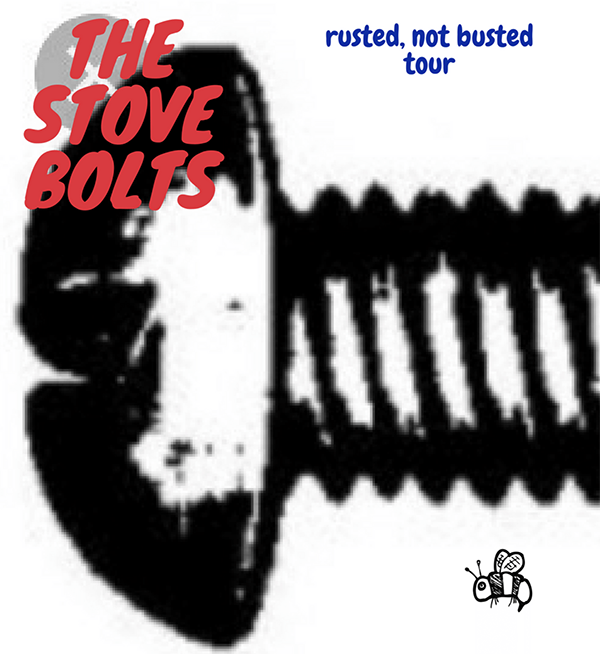
Featuring:
“The Stove Bolts”
Mead the Day Away with The Wandering Bard Meadery
Fresh Crafted Micro Brews served by Appalachian Ale House
Father’s Day is just around the corner and many of your fathers are beekeepers. So, I’d like to make a few suggestions of beekeeping gifts that would complete your Father’s Day shopping.
Start with a good book about Beekeeping and one that includes recipes so the entire family can enjoy your fathers honey at the table. I recommend The Beekeeper’s Bible.
Then add the Bee Hive Smoker Go Cork It Topper Stopper which is something that every beekeeper really needs so that we don’t set the woods on fire as we’re driving down the road! Believe it or not, but this has actually happened a time or two and caused horrific forest fires. Don’t be that guy! And, for only $6.99 it’s an inexpensive gift and one your beekeeper Father will love.
One of the cool things about shopping for beekeeper Fathers is the effort to try to find a gift that they normally don’t see anywhere, and one of the fascinating tools that I’ve discovered is the Multifunction Hive Scraper Tool With Wooden Handle.
It can be used for cleaning up old frames or scraping the top bars of beehives just a very good tool for a father to have that will enhance his ability as a Beekeeper.
Every beekeeper wants to have more beekeeping colonies. Unfortunately, sometimes the cost gets in the way of this dream. Some Beekeepers are able to catch wild swarms that fly by. If you purchase the Swarm Commander Swarm Lure Vials 5 Vials
, it will attract more honeybees to explore your fathers empty boxes therefore he could catch a swarm as it passes by which means free bees and
To top off your father’s wardrobe, buy him The Beefather Shirt
. This is a fun beekeeping shirt for your father, and it’s also a great conversation peace. He will love it!
Happy Father’s Day from Bee Well Honey!
The vast majority of beekeepers expect a payday in the summer months when they harvest their honey but farming and beekeeping doesn’t always follow our journals.
Beekeepers definitely fall into the trap of doing the math before the honey is safely in a jar. This year in particular was somewhat of a phenomenon, at the very least a rare occasion.
The overwintered colonies were stronger than I have ever seen and could have been split easily in January and February. The tricky part was the weather was remaining cold and the possibility of chilled brood on cold nights kept most from risking the task.
Secondly in order to make productive splits you need properly mated queens and due to the colder weather that too made for a challenge. The more experienced beekeepers noticed the unusual climate and proceeded with caution.
Once spring arrived the cold weather had held back so many nectar bearing plants that when warmer weather arrived everything busted at the same time and created a massive honey flow which was fun and exciting, not only were the bees buzzing but social media was buzzing with “It’s going to be a big year for honey!”
THEN CAME THE RAIN!!!
I suppose most beekeepers were able to sneak some honey off of their colonies but most were and still are waiting for the end of the honey flow. There are many hardwood trees and other nectar bearing plants that are still to bloom but the torrential downpours could cause a problem.
You see, when honeybee colonies are making honey and carrying in pollen really fast the queen is laying eggs really fast. Those eggs hatch out in 21 days so most colonies are busting at the seams RIGHT NOW. These colonies have produced a lot of honey and a lot of bees but the rain is keeping them inside which is a BIG PROBLEM.
All the bees hanging out inside the hive create a crowded space. In anxiety, some will produce queen cells and will throw swarms as soon as the sun shines again creating a second swarm season.
All of the bees are also hungry and since the weather is not allowing the bees to gather nectar they are eating the honey they have stored.
Beekeepers could be surprised to see that after the rain clears and they return to the hive to harvest the honey crop that the crop magically disappeared.
I did notice over the holiday weekend that between rain showers the bees were flying. My hope is that they were able to maintain incoming nectar to replace the nectar eaten on the days of endless rain.
In a nutshell I suppose we will just have to wait and see what happens. There is a possibility that the excess of water in the ground could cause a massive nectar fall flow which would be something we really never have seen in Upstate South Carolina.
I suppose as farming goes we will just have to wait and see. Either way, this is a good learning experience for us to watch this unusual season unfold.
Bee Well Honey,
Kerry Owen
Check Out Our Other Blog Posts On Beekeeping
Beekeeping Tips: Preparing for Moving Bees
I really don’t know why it took me 20 years to discover this but now that I’ve discovered it I thought I would share it with all my beekeeper friends.
So how many times have you been in a bee yard and needed to do something that required power?
I found this little compact generator that is like the best thing ever! Its made by Ryobi and it’s a 2300 Watt. What I like the best is it’s light and small but has the power to run any tool. It literally rolls around like a suitcase and it takes up no room in the truck and now if we need power in the bee yard or breakdown with a load of bees, all we do is start up this Ryobi generator and plug up our squirrel fan.
I love it!
I have found now that I have it and it is so light weight that I use it all the time now around the house and around the shop it’s easier to use sometimes than to run an extension cord.
Just one more tip that might make you more productive.
Check out my other Beekeeping Tips
All beekeepers search for ways to save money so they may enjoy their hobby to the fullest. I, too, fit into this category but have found it very challenging to find the perfect outfit for my situation.
I am in my bees almost daily and during the day I may be at the bank or the post office mailing queen bees etc., and I obviously can’t drag myself around all day in a sweaty bee suit.
I have found that there is a very easy solution to this problem and the best part it is cost effective. You may consider these 5.11 Tactical Taclite Pro Pants . I choose these for many reasons.
These pants have a nice stretch in the waist that allows full movement while bending over to work colonies and a nice baggy thigh cut that allows stepping up and down off trucks easily. They also so have nice big pockets where I can store my queens, hive tools and marking pens.
My favorite part is the phone pocket since wearing a phone holder is not preferred in the bee yard due to losing your phone or not allowing your bee jacket to fit snug around your waist. They are also extremely durable and come in lots of colors but I like the Kaki and Charcoal.
The very best part is it’s not a one use item like a bee suit, and you can wear these for any occasion. Just another way you can save money on your beekeeping gear.
So, you have honey in your hives. How do you get it out?
Your Supers vs Their Supers
 Once your bees have filled up their hive body, and 8-9 frames in their first super, you can add a queen excluder, and the first of your honey supers.
Once your bees have filled up their hive body, and 8-9 frames in their first super, you can add a queen excluder, and the first of your honey supers.
You will let them fill this super 8-9 frames full as well before adding more.
Checking the Frames
 At the end of the last major nectar flow, you’ll check each frame for capped honey. You want to make sure the majority (80& -90%) of the frame is capped.
At the end of the last major nectar flow, you’ll check each frame for capped honey. You want to make sure the majority (80& -90%) of the frame is capped.
Beginning Beekeeping Class
Who Wants to be a Beekeeper ?
This 2 hour introductory level beekeeping class covers basic honeybee behaviors.
Cost: $20
Raffle Prize: 3 lb Honeybee Package with MARKED QUEEN.
Location
Bee Well Honey Bee Supply
815 W. Main Street
Pickens, SC 29671
Class Schedule
March 31, 2018
10:00 am – 12:00 pm
Includes:
– Proper beekeeping management skills
– Pros and cons of beehive selections on the market
– Covers all basic beekeeping equipment thoroughly
– How to choose a proper bee yard
– Swarm control
– Installation of honeybees into the beehive
– Honey extraction and bottling process
– In-depth Q&A session
– Tour of our award winning facility
Class Instructor – Kerry Owen

Soap Making Class
Interested in learning how to make soap?
Come join us for our two hour class that will teach you the basics of making handmade soap.
- Date: March 17, 2018
- Time: 10:00 a – 12:00 p
- Cost: $20.00
Class Instructor – Jennifer Bridges – Owner of Soap Suds & More in Pickens, SC

Jennifer is the owner of Soap Suds & More and a partner at Brownstone Spa & Boutique in Pickens, SC. She became interested in soap making when she began researching the various things that could be done with essential oils. This research led her to websites about making soap which peaked her interest and started the journey.
Jennifer began her business of soap making just over four years ago and feels that it is a great privilege to have her job also be her much loved hobby. She loves being a small, local business and having the opportunity to see the faces of her customers, most of whom quickly become friends!
Kombucha Making Class
Kombucha is essentially a fermented tea drink and has risen in popularity thanks to its unique taste and its health benefits. Those benefits include boosting the body’s immune system, improving digestion and gut health and also being a healthy alternative to sugary sodas and juices.
Class participants will learn each step of the kombucha making process, from prepping the tea and flavoring to how best to store your kombucha starter.
- Date: February 3, 2018
- Time: 10:00 a – 12:00 p
- Cost: $20.00
Class Includes
- Prepping the tea
- Flavoring
- How to store the kombucha starter
Bee Well Honey Bee Supply and Bee Well Honey Natural Market are having a 10% off everything sale (excludes Bees, Honey, Gift Certificates, and Classes) now through December 23.
Purchases of $100 or more get a FREE Bee Cause T-shirt ($25 value) while supplies last.
I can relate to this question because – before I became interested in honeybees I had no idea how to buy them. My first hive was a gift from a friend. Funny thing was, he actually brought it to me in the backseat of a Camry with the seat belts around it to secure it. The two kids in the backseat were terrified! Probably the quietest trip that family ever made.
After I became obsessed with honeybees, I had to get more. Problem was I just wasn’t sure exactly how to do that.
Luckily for me I did reach out to the old time beekeepers in my region. I met a beekeeper named Mr. Gentry, and he invited me travel with him to buy bees in Vernon, Georgia from John Hardeman at Hardeman Apiaries. I gladly jumped at the chance to go, bu he made me drive. In fact he made me do all the grunt work but I loved the experience, especially since I had none.
When we arrived it was astonishing to me. Bees were everywhere – and I mean everywhere!
There were hundreds of little screened boxes – better known as packages. Each Honeybee Package contained 3 lbs of bees and a queen in a little wooden box. It was amazing! At this point I was searching for answers about the bee business and John Hardeman invited us into his house for lunch.
John’s wife met us at the door and gave me a good looking-over. I started politely asking questions, and of course, enjoying the food!
These were great people. I asked John, ” If you had to start over would you have still do honeybees?” He smiled and patted his wife on the shoulder and replied, “yes, but I would have started a lot sooner”. That’s all I needed. That was the day I started my bee business.
I bought fifty 3 lb packages of honeybees, and Mr. Gentry bought fifty. That was almost 20 years ago and now Bee Well Honey is the largest honeybee and beekeeping supply company in South Carolina.
We are serious about educating new beekeepers and carefully explain to them what a honeybee package is. We also make sure they understand how to care for them. We would never consider just pitching a package of bees in a car without making sure the customer knows how to care for them. Thus the reason for this blog.
Beekeepers who wish to sell honeybee packages are a unique group of individuals. The great ones know how to rely on other beekeepers and relationships to share methods, ideas, equipment, employees, queens, queen cells and the list goes on and on. But, the most important thing we share is failure.
Bee farmers continuously share things that they try, but did not work. Therefore they learn how to try it again, but in a different way. They never give up. They just keep trying until they get it right. Being a honeybee package bee provider is not easy and I have the greatest respect for all of them.
What Is A Honey Bee Package?
A package of honeybees contains approximately 3 lbs of honeybees, nurse bees, forage bees, guard bees, drone bees – which is a supreme mix of bees of all ages. This is critical for the longevity of the colony while waiting for the bees to establish themselves in a hive and for the queen to start laying eggs.
It will be 21 days before new bees start hatching after the comb is drawn out far enough for the queen to start laying eggs.
There is a freshly mated queen trapped inside a small wooden cage with sugar candy filling a hole in one end. The honeybees begin eating the candy and eventually the queen is released. This gives the colony time to get used to the smell of the new queen. Everyday some bees die until the new bees begin to hatch and then the colony explodes with honeycomb bees and honey.
It truly is one of the most fascinating things I have ever seen. Guess that’s why I am in the business. Bee Well and Good Luck!
Mead Making Class
Learn how to make the world’s oldest fermented beverage in our Mead Making Class. We will demonstrate how to make a simple mead. When done correctly, home brewed mead will be the best you’ve ever tasted.
Join us and see how simple it is.
- Date: December 2, 2017
- Time: 10:00 a – 12:00 p
- Cost: $20.00
Class Includes
- Mead Making Demonstration
- The History of Mead
- Special Mead Fermentation Techniques
- Mead & Honey Tasting
- Discussion of Different Mead Styles
Package Bees
Our 3 lb Honey Package Bees are now on sale for the 2018 season. Our Italian Hygienic Bees with young Mated Queen are available for pickup only.
Package Bees Available Pick Up Dates
- March 31, 2018 – On Sale Now
- April 14, 2018 – On Sale Soon
- April 21, 2018 – On Sale Soon
5 Frame Nucs
Our 5 Frame Honeybee Nuc Bees Colony is packaged in a Jester Box (Plastic) and is now on sale for the 2018 season. Only available pickup.
We raise these nucs ourselves. Local bees from the upstate! And, our nucs are raised without chemicals and fungicides.
We are accepting orders fro spring 2018, however no pick up date has yet been schecduled. We will commuicate this date soon.
Kerry Owen recently appeared on Scene on 7 to talk about Bee Well Honey. Click Here to Watch.
There are numerous factors that go into the decision when to harvest honey from hives. Be patient. The bees need appropriate time to collect nectar and process it into honey. Rush the process and harvest before it is fully ripened by the bees and you may end up with fermented honey. Not the end of the world since it is still edible and makes great mead, but if high quality honey that stores well or is for sale is your goal, low moisture is what you want.
A good rule of thumb is to not extract unless at least 75% of the cells in the honey combs are capped. By extracting one uncapped honey frame for every three capped frames of honey, the overall moisture content will tend to be below the level where fermentation will occur.
Honey Bee Forage Map
For more information about the ideal time to harvest honey in various parts of the U.S., check out NASA’s Honey Bee Forage Map by clicking here.
Bee Well Honey Farm Presents SC Beekeepers Association Summer Conference 2017
Please make plans to join us for the annual summer conference of the South Carolina Beekeepers Association to be held at The Florence Civic Center July 19-21, 2017.
More Information/Conference Registration
More Information/Vendor Registration
Keynote Speakers
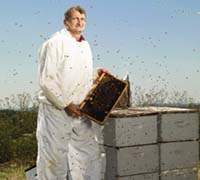 David is an American commercial beekeeper who began keeping bees as a FFA project in 1962 at Mifflinburg Area High School in Pennsylvania. He started Hackenberg Apiaries, which he runs with his son David. Hackenberg Apiaries moves bees for pollination throughout the United States.
David is an American commercial beekeeper who began keeping bees as a FFA project in 1962 at Mifflinburg Area High School in Pennsylvania. He started Hackenberg Apiaries, which he runs with his son David. Hackenberg Apiaries moves bees for pollination throughout the United States.Mr. Hackenberg has been featured in two documentaries about Colony Collapse Disorder, Vanishing of the Bees and Colony: the Endangered World of Bees and has represented the beekeeping industry in front of congress on issues concerning pesticides.
Mr. Hackenberg received the Presidents award from the American Beekeeping Federation in 2008 for bringing the plight of the honey bee to light in the world.
Mr. Hackenberg will share with us what he has seen in bees from the commercial standpoint and how we can as Backyard/Sideliners apply some of the lessons he has learned along the way.
Jennifer for the past 17 years, Jennifer Berry has been the Apicultural Research Professional and Lab Manager for the University of Georgia Honey Bee Program. Her research objectives have focused on improving honey bee health, the sub-lethal effects of pesticides on beneficial insects and IPM techniques for varroa and small hive beetle control.
More recently, Jennifer has undertaken several ambitious campaigns to educate people from all walks of life. She’s volunteered in Central and South America to teach women and young teens the art of beekeeping in order to enhance their ability for better employment and hopefully improve their quality of life. Jennifer has also been instrumental in launching the Georgia Beekeeping Prison Program by certifying inmates through the University of Georgia Master Beekeeper Program. In little over a year, 5 prisons have been added to the fold and are now teaching beekeeping behind bars. Three classes have already been certified, with many more to come. Plus, the prison program is striving to become as self-sustaining as possible, with each prison responsible for supplying something to the mix: queens, bees and/or woodenware. And finally she has been dutifully educating the public about the importance of pollinators and other beneficial insects and how to encourage their populations.
Jennifer is a regular columnist for Bee Culture magazine and occasionally for other publications across the pond. She travels extensively to speak to local, state, national and international students, groups and beekeeping associations. On weekends and evenings, Jennifer operates Honey Pond Farm, a honey bee venture which strives on rearing healthy bees and selecting queens for varroa tolerance, brood production, gentleness, and longevity. Several times a year she sells nucleus colonies and teaches how to rear superior queens at her farm in Georgia.

Dr. Sharashkin is founder of HorizontalHive.com and editor of Keeping Bees With a Smile, a comprehensive resource on keeping bees naturally in horizontal hives. He is contributor to American Bee Journal, The Beekeepers Quarterly (UK), and Acres USA, and speaks internationally on sustainable beekeeping, organic growing, and Earth-friendly living. He holds a PhD in Forestry from the University of Missouri and a Master’s in Natural Resources from Indiana University. Author of world-renowned research in sustainable agriculture, he lives with his wife and four children on a forest homestead in the Ozarks in southern Missouri where they raise bees in a variety of low-maintenance, easy-to-build horizontal hives.
Dr. Tsuruda has been the SC Apiculture Specialist since 2014. Her studies in honey bees began in California, where she worked on foraging behavior and genetics. She worked as a postdoctoral researcher at Purdue University and studied behavioral resistance to Varroa mites and genomic imprinting. Jennifer maintains Clemson University’s hives for Extension and Research and serves the professional community as past president of the American Association of Professional Apiculturists, former chair of the STEP committee of the Entomological Society of America, and vice chair of the Heartland Apicultural Society.
We love this time of year. The trees are green, flowers are beginning to bloom and the weather is warm. Ah, the lazy days of summer.
Summer is perfect for honey bees…. right? So, what is summer nectar dearth?
What is Summer Nectar Dearth?
Honey bee colonies store nectar and pollen to use in times of dearth. To a honey bee, a dearth is a shortage of nectar-producing flowers. The most obvious nectar dearth occurs during the winter, but many places also experience a summer nectar dearth, a hot and dry period between spring flowers and autumn flowers.
This time of shortage may escape a new beekeeper’s notice because, after all, it is summer and the world is green. Sometimes flowers are clearly visible and it’s easy to assume that if flowers are present, the bees are happy. But not all flowers produce nectar accessible to honey bees. And among those that do, the amount of nectar can be reduced by low rainfall, excessive heat, or other less-than-ideal growing conditions.
The summer nectar dearth can be devastating to a honey bee colony. At times, it can destroy a colony faster than a cold winter. Whereas a bee colony has time to prepare for winter by increasing storage and decreasing population, a summer dearth hits when populations are very high. Large numbers of bees—especially active bees—require a lot of food. A large colony can wipe out its warehouse very quickly, and if the beekeeper has already harvested, the problem is worse.
Desperate times call for desperate measures, and a severe summer nectar dearth can cause many types of unwanted behavior. Simply put, idle bees get into trouble.
What Should a Beekeeper Do?
Once you recognize a dearth, you may want to take actions to minimize the damage a dearth can cause. Listed below are some considerations for colony management.
- Feeding syrup during a summer dearth is a two-edged sword. On the one hand, if your colony is low on stores, feeding may keep them from starving. On the other hand, the presence of feed can quickly alert robbers to a feast. If you decide to feed, resist using an entrance feeder because the odor will bring robbers right to the front door. Instead, use an internal or enclosed hive-top feeder and avoid drips and spills.
- If you have a strong nectar flow in autumn, feeding bees during the summer dearth has advantages. Normally, the hive population drops during a dearth because when nectar stops coming in, the queen restricts her egg laying. A good supply of syrup keeps the colony population higher, and a bigger colony going into autumn will be better able to harvest the late nectar flows.
- If you decide to feed colonies during a dearth, do not use essential oils or Honey-B-Healthy. At this time of year, these products can entice bees from miles around. Don’t worry, your bees will have no trouble finding the syrup in their hive.
- Reduce entrances. Robbing is always a possibility even if you are not feeding. Reduce your entrances and, for small or weak colonies, consider using a robbing screen.
- Close upper entrances. It is harder for your bees to defend two or more entrances. If you are using upper entrances, close them off during the dearth. If you need upper ventilation use a screened inner cover or an eke (two- or three-inch super) with screened ventilation ports.
- Do not put community feeders or wet frames near your apiary. Either one can start a frenzy that invites robbers to your area. If you want your wet frames cleaned by your bees, put the frames in a super inside the hive.
- If possible, schedule hive manipulations for late in the day. Bees go home at night, so opening hives late in the day allows time for the odors to dissipate before morning. It also gives nighttime scavengers an opportunity to clean up any drips and spills.
Bee Well Honey Farm recently appeared on Field Trip Zoom to discuss “How to Become a Beekeeper”. Field Trip Zoom provides live and interactive educational experiences between educational content providers and K-12 educators, students and homeschoolers.
This presentation is aimed at ages 5-6.
Video Links
Estimated reading time: 2 minutes
Do you have friends who are beekeepers? Maybe you’ve thought trying beekeeping, but you’re not sure where to start.
Well, beekeeping can be a lot of fun… if you have the right tools and know what you need.
Here are some questions and answers to consider.
How much time does it take to keep bees?
Beekeeping is a seasonal hobby, and therefore, the time varies with the seasons. In the winter, there is practically nothing to do except to occasionally check for physical damage or snow blocking the entrances. The busiest time is in the early summer when each hive should be checked weekly to prevent swarming, and to add additional honey supers. This need take no longer than a few minutes once you get the hang of it.
How hard is beekeeping?
Beekeeping does require some strength, and a bit of physical labor, but it’s not too hard. And, you can always reach out for help from other beekeepers or beekeeping suppliers.
How much will it cost me to get started?
Bee Well Honey offers an inexpensive Beginner Kit – Click Here to Learn More. This contains all the equipment you will need to start your first hive.
How much honey can I expect from my hive?
After the first year – once the colony is built up, a hive can produce anywhere from 20 lbs – 70 lbs annually.
Will I get stung?
Well, the better question to ask is “will it hurt when I get stung”? It really isn’t as bad as you might think. Stings on the hands and arms don’t really hurt much, if you learn to remove the sting properly. Some seasoned beekeepers actually enjoy the first stings of the year. It means that spring is surely here.
Where can I buy bees?
We’re glad you asked. Bee Well Honey has been selling bees since 1999. Our expert staff is ready to help you. Check out our Bees For Sale by Clicking Here.
Will the bees bother my neighbors?
No, not usually. Remember to locate the bees’ flight path away from traveled areas. Often, if the hives are hidden from view, no one even knows they are there.
